TheDePaulia
 By Ruchi Nawathe Nation & World Editor
By Ruchi Nawathe Nation & World Editor

 By Ruchi Nawathe Nation & World Editor
By Ruchi Nawathe Nation & World Editor
DePaul junior Kalixta Drinkard stood waiting for the Brown Line at the Fuller ton station before class. She started her journey 50 minutes before her class be gan. The train arrival times on the screen at the station were unavailable, but Drinkard had little hope that the train would arrive in time.
“The other day… I was almost late to my journalism class going to the Loop campus,” Drinkard said. “I had to mes sage my teacher. I told her I might be late. She said that other kids were saying the same thing because they were taking the train also.”
According to Google Maps, taking the Brown Line from the Lincoln Park campus to the Loop campus takes ap proximately 24 minutes.
There are multiple factors contribut ing to delays and absences in CTA tran sit, but the leading cause is a shortage of CTA operators.
“The unreliability of overall tran sit services is directly correlated with
a shortage of bus and rail operators – a nationwide issue not only impacting public transit agencies like the CTA, but also other industries requiring commer cial drivers, such as school buses, deliv ery services and other commercial enti ties,” CTA Media, who did not specify a spokesperson, told The DePaulia.
According to CTA Media, the corona virus pandemic is another factor impact ing CTA service, since CTA operators are occasionally calling in sick to take care of themselves or their families.
“As of mid-October, there are 741 rail operators, which is 108 fewer than the start of the pandemic,” CTA Media said.
“On the bus side, there are 3,152 full-time bus operators as well as 79 part-time. Currently, CTA needs approximately 500 additional bus operators to help fulfill current scheduling levels.”
Since starting at DePaul, sophomore Isabel Riley has used the CTA almost dai ly.
“I’ve definitely noticed [delays] get ting worse over the time I’ve lived in Chi cago,”
 By Erin Henze Asst. Photo Editor
By Erin Henze Asst. Photo Editor
DePaul University made history sev eral weeks ago when it announced its plan to implement the “Women’s Athletics Ad vancement Fee.” This initiative will add $1 to the face value of any men’s basket ball admission ticket, with the profit to be distributed amongst the university’s female athletic programs. DePaul is the first known Division I university to unveil such a plan.
“I think it’s an excellent idea,” said Frederick Mitchell, DePaul professor and award-winning Chicago Tribune sports writer. “I think it could put pressure on other universities to do the same thing and say, ‘DePaul is doing this, so why aren’t we doing it?’ I think it has the po tential to enhance the profile of the entire athletic department at DePaul.”
The idea for the new initiative sprung up during the Athletic Department’s dis cussion about the 50th anniversary of Title IX and how the milestone could be used as an opportunity to highlight the need for funding in women’s athletics.
“Once the idea was established and we

knew what we were going to do, it real ly didn’t matter to me what other people thought because I knew at that juncture that this was going to be something that really helps bring some attention to wom en’s athletics,” DePaul Director of Ath letics DeWayne Peevy said. “There was a really good discussion about how we wanted to do things because we didn’t want it to look like it was coming from a PR standpoint.”
Peevy and the rest of the athletic de partment hope that this new initiative will garner a profit of at least $50,000 to be distributed among the nine women’s ath letic teams at DePaul.
“I think we came up with that strategic number by determining what was feasible and what would be a goal for us to reach for,” said Kassidy Brown, senior associate Athletics Director of Marketing & Com munications. “Once we are able to get the funds we will start looking at which areas, which scholarships, and which ways we can best use it for our female student-ath letes at DePaul.”
DePaul has one of the lowest athletic revenues in the Big East, reporting only $29 million in the 2020-2021 season per the U.S. Department of Education. This
Senior guard Kierra Collier brings the ball up against St. Johns on Jan. 28 2022. Women’s basketball is one of nine programs that the new ticket fee initiative hopes to benefit.The DePaulia is the official student-run newspaper of DePaul University and may not necessarily reflect the views of college administrators, faculty or staff.
EDITOR-IN-CHIEF | Erik Uebelacker eic@depauliaonline.com
PRINT MANAGING | Nadia Carolina Hernandez managing@depauliaonline.com
ONLINE MANAGING | Patrick Sloan-Turner online@depauliaonline.com
MULTIMEDIA MANAGING | Amber Stoutenborough multimedia@depauliaonline.com
NEWS EDITOR | Kiersten Riedford news@depauliaonline.com
ASST. NEWS EDITOR | Vanessa Lopez news@depauliaonline.com
NATION & WORLD EDITOR | Ruchi Nawathe nation@depauliaonline.com
OPINIONS EDITOR | Samantha Moilanen opinion@depauliaonline.com
FOCUS EDITOR | Una Cleary focus@depauliaonline.com
ARTS & LIFE EDITOR | Lilly Keller artslife@depauliaonline.com
ASST. ARTS & LIFE EDITOR | Jonah Weber artslife@depauliaonline.com

SPORTS EDITOR | Tom Gorski sports@depauliaonline.com
ASST. SPORTS EDITOR | Preston Zbroszczyk sports@depauliaonline.com
ART EDITOR | Alicia Goluszka art@depauliaonline.com
ASST. ART EDITOR | Maya Oclassen art@depauliaonline.com
PHOTO EDITOR | Quentin Blais photo@depauliaonline.com
ASST. PHOTO EDITOR | Erin Henze photo@depauliaonline.com
COPY EDITORS | Amber Corkey | Kara Zubo copydesk@depauliaonline.com
SOCIAL MEDIA EDITOR | Lily Lowndes social@depauliaonline.com
ADVISOR | Marla Krause mkrause1@depaul.edu
Drug & AlcoholAssault & Theft Other
Lincoln Park Campus Crimes: Oct. 13
1) A Theft report was filed regarding a bike stolen from the rack in front of Arts & Letters. Oct. 14
2) A Criminal Damage to Property report was filed regarding damage to the door at University Hall. Oct. 15
3) A Possession of Marijuana report was filed in Belden and Racine Hall.
4) A Smell of Marijuana report was filed in Centennial Hall. Oct. 16
5) A Smell of Marijuana report was filed in Centennial Hall. Oct. 17
6) A Smell of Marijuana report was filed in Centennial Hall.
7) A Sexual Harassment
report was filed regarding an incident in the Schmitt Academic Center.
Loop Campus Crimes: Oct. 14
1) A Graffiti report was filed for markings on the Daley Building. Oct. 15
2) A Graffiti report was filed for markings on the Reskin


Theatre.
3) An Armed Robbery report was filed regarding a robbery that occurred in the 7-Eleven at Jackson and Wabash.
A Safety Alert was issued regarding the incident. Oct. 16
4) A Criminal Trespass Warning was issued to an offender in the DePaul Center.
CORRECTION: An earlier version of the article " We all scream for ice cream (and answers): President Manuel holds ice cream vision session," published on Oct. 17, implied a university official was inaccurate in stating the number of attendees at Blue Demon Welcome. It has since been corrected.
CORRECTION: An earlier version of the article "Printing problems: Students lose over $100 in printing credit," published on Oct. 17, had an inaccuracy related to the fee structure and source of funds for student printing services. It has since been corrected to accurately reflect that printing service funds are included in students’ tuition at DePaul.




La DePaulia es el noticiero oficial estudiantil en español de la Universidad DePaul, enfocado en proveer una voz para la comunidad latinx. Nuestras opiniones no necesariamente reflejan las opiniones de la administración, facultad o personal de la universidad.

JEFA DE REDACCIÓN | Jacqueline Cardenas eicladepaulia@depauliaonline.com
GERENTE EDITORIAL | Santiago PosadaJaramillo managingladepaulia@depauliaonline.com
EDITORA DE OPINIONES, ARTE Y VIDA | Andrea Juárez Hernández opinionesladepaulia@depauliaonline.com
EDITOR DE MULTIMEDIA | Frankie Perez multimedialadepaulia@depauliaonline.com
PRODUCTOR DE PODCASTS | Geovani Camarena gcamare3@depaul.edu
EDITOR DE COPIA | Rodrigo Melgarejo a20181375@pucp.edu.pe
EDITOR DE DEPORTES | Santiago Gonzalez Tijerina sagotijerina@gmail.com
thedepaulia
facebook.com/TheDePaulia twitter.com/TheDePaulia
thedepaulia
www.depauliaonline.com
GENERAL PHONE (773) 325-2285
OFFICE HOURS Friday: 10 a.m. to 5 p.m. Sunday: 10 a.m. to 5 p.m.
ADVERTISING business@depauliaonline.com
NEWS TIPS news@depauliaonline.com
ADVERTISING business@depauliaonline.com
DePaul released a comprehensive map of gender-neutral bathrooms in Lincoln Park and Loop Campus this past week.
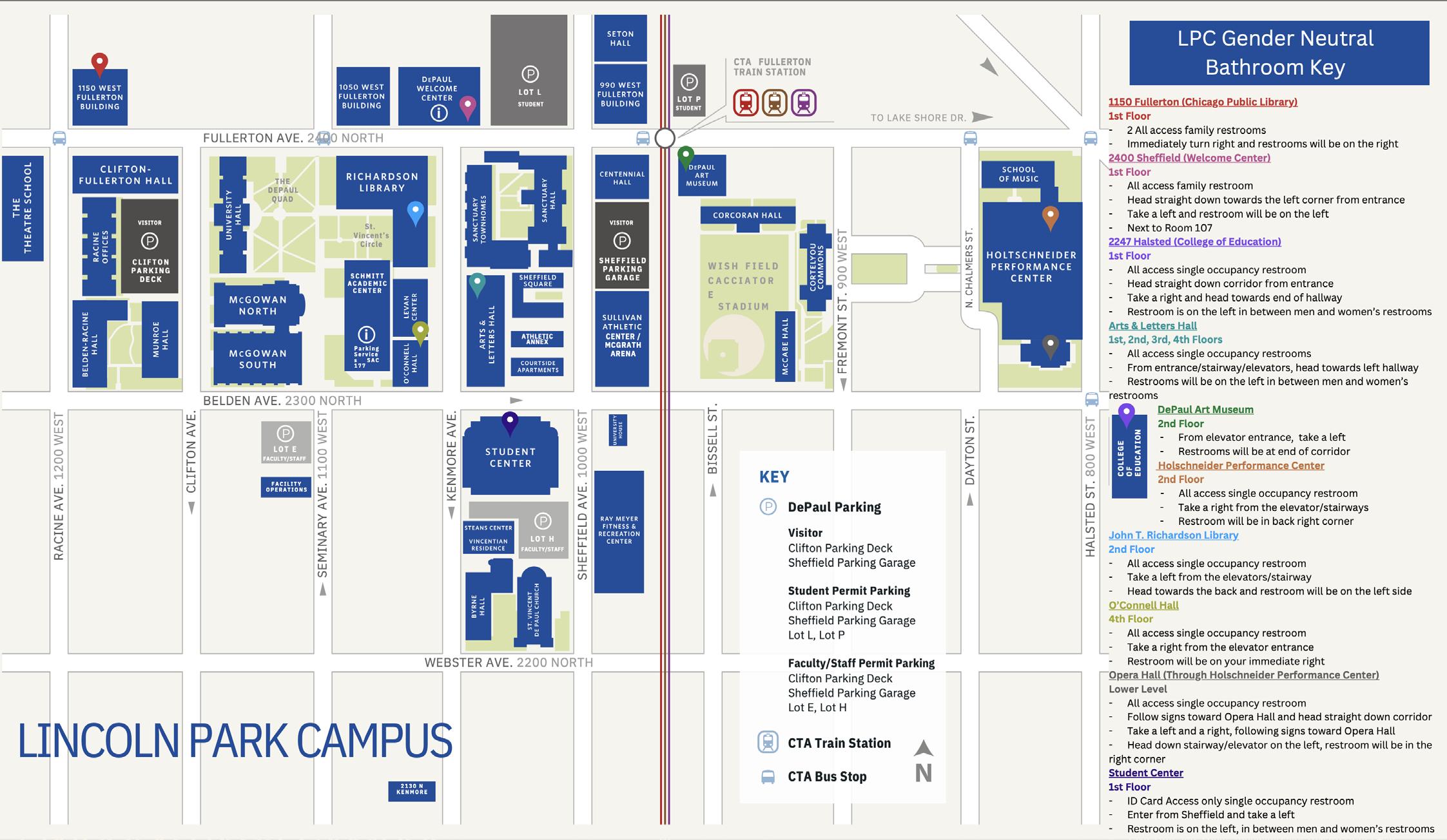
The list includes all single occupancy, gender-neutral or “family” restrooms in Lincoln Park and Loop. A published map on DePaul’s website will create accessi bility for students to know where the re strooms are located.

The Arts & Letters Building, built in 2011 in Lincoln Park, is the only building with a gender neutral bathroom on each floor. Other buildings require students to travel between floors, regardless of gender, such as Levan Center which has different gendered bathrooms on each floor.
All gender-neutral restrooms are sin gle stalls which can create problems for students.
A single stall means longer wait times for people who wish to use these re strooms. A junior DePaul student who wished to remain anonymous shared their experience.
“In my winter quarter of last year, I had all of my classes only in Arts and Let ters, and they were all in one day,” they said. “I was constantly in the building that had the most accessibility and there were still many instances where I was like, ‘do I take the time?’”
Gender-neutral restrooms with a sin gle stall assist students who wish to have a private restroom experience free from po tential discrimination in gendered bath rooms.
“It is frustrating because as a trans person, that's the place that I feel the most comfortable,” the anonymous student said.
They also shared that it was frustrat ing to have so few accessible restrooms be available to everyone which further exac erbates the problems with wait time.
Aside from the exclusive list, the Di vision of Student Affairs has a bathroom map for each campus listed on their web site page. The LGBTQIA Resource Center added both maps to their resource guide.
Samantha Close, an assistant professor of communication at DePaul, says stu dents may not know about this resource.
“I didn't know that that map existed, and I think that kind of highlights the problem with relying on student affairs,” Close said. “Students might not necessari ly go [to the website].”
DePaul does not have any bathrooms that are both gender neutral and have multiple stalls. Kelly Kessler, DePaul pro fessor of media and cinema studies, spoke about the importance of having more than single stall, gender-neutral restrooms and the statement it makes to do so.
“I think when you go beyond a ‘onesie’ [single-stall bathroom], you make a state ment about the normalcy and necessity of gender neutral bathrooms,” Kessler said. “Having a ‘onesie’ is like, ‘Okay, we have solved this problem in the simplest phys ical and ideological way.’ It doesn't nec essarily make a statement about the need and importance.”
One of the main problems with the re strooms is a lack of awareness. Although there are no official DePaul statistics about transgender, non-binary or gedner fluid student student enrollment due to stu dents not required to disclose their gender identity, the accessibility will make a dif
ference in the DePaul community, Before the published map, students relied on so cial media to inform each other.
The account @genderneutraldepaul posts detailing directions to gender-neu tral restrooms on campus.
Students want to see more clear signs and indicators of these bathrooms and their location.
“If we have a limited number of gen der-neutral bathrooms per building, it would seem somewhat useful for there to be some kind of signage directing people,” Kessler said.
DePaul is undergoing initiatives such as All Gender Housing.
DePaul hosted a flu vaccination clin ic in the Lincoln Park Student Center in Room 315 on Oct. 19. Students were of fered a free flu shot, regardless of their insurance status, as long as they regis tered for a timeslot. The workers estimate that over 200 students came for their shot at the drive.
DePaul partnered with Ascension SAGE Medical Group to put on the clin ic. Ascension SAGE Medical group will host one more flu shot clinic and two Covid-19 booster clinics. The next flu clinic is Thursday, Oct. 27, in the Loop Campus in DePaul Center Room 8012. The Covid-19 booster clinics are on Thursday, Nov. 3, in the Lincoln Park Student Center in Room 324 and on Thursday, Nov. 10 in the Loop Campus in DePaul Center Room 8012. Students can register for the clinics on DeHUB.
Kevin Kwiatkowski, one of the volun teers working the clinic who has worked in healthcare for 10 years, said even though registration is preferred for those wanting to get vaccinated, walk-ins are still welcome.
“This is the only college vaccine drive that I have participated in,” Kwiatkowski said.
Once a student arrives, Kwiatowski gives them paperwork to fill out with their medical information, takes the stu dent’s temperature and gives them the flu shot. The process takes less than five minutes for each student.

Clinic volunteers efficiently moved each student through the clinic so every one who wanted a shot could get one.
Socorro Juarez, a SAGE clinic staff member, estimated around 200 vaccines were distributed to DePaul students by 1 p.m. She said that is more than double the amount of flu vaccines that were dis tributed at last year's clinic.
“We provide services that some stu dents can not afford. Some have private insurance or no insurance at all, so mak ing this affordable and accessible to ev eryone is very important,” Juarez said.
Isasias Torres, a DePaul Student Health Clinic worker, has worked in the healthcare field for 26 years and believes that these clinics are crucial.
“These drives are important because they promote good health and protection from the flu or other diseases as well,” Torres said.
The flu vaccine clinic is one of the many services that DePaul offers to pro mote health and wellness among students and staff. These programs have become more popular since the beginning of the Covid-19 pandemic.
While there are some anti-vaccine people at DePaul, the workers at SAGE clinic have noticed a shift in the number of people who are anti-vaccine over the years.
“I think Covid made people more likely to get their vaccines and stay healthy,” Juarez said. “I’ve noticed people asking to get any vaccine that they are due for when they come in which I think is a result of Covid and everyone trying to stay up to date on their shots.”
The global pandemic has made some people much more aware of public health. Torres hopes that this newfound awareness will help people get through what he predicts to be a rough flu season.
“I feel like people are less resistant to getting vaccinated due to the pandemic,” Torres said. “It has been reported that this flu season will be very severe. So far
we’ve been seeing a lot of our patients at the clinic get vaccinated this flu season.”
The healthcare workers at the flu vac cine drive had some advice for DePaul students when it comes to getting vacci nated for the flu and other illnesses.
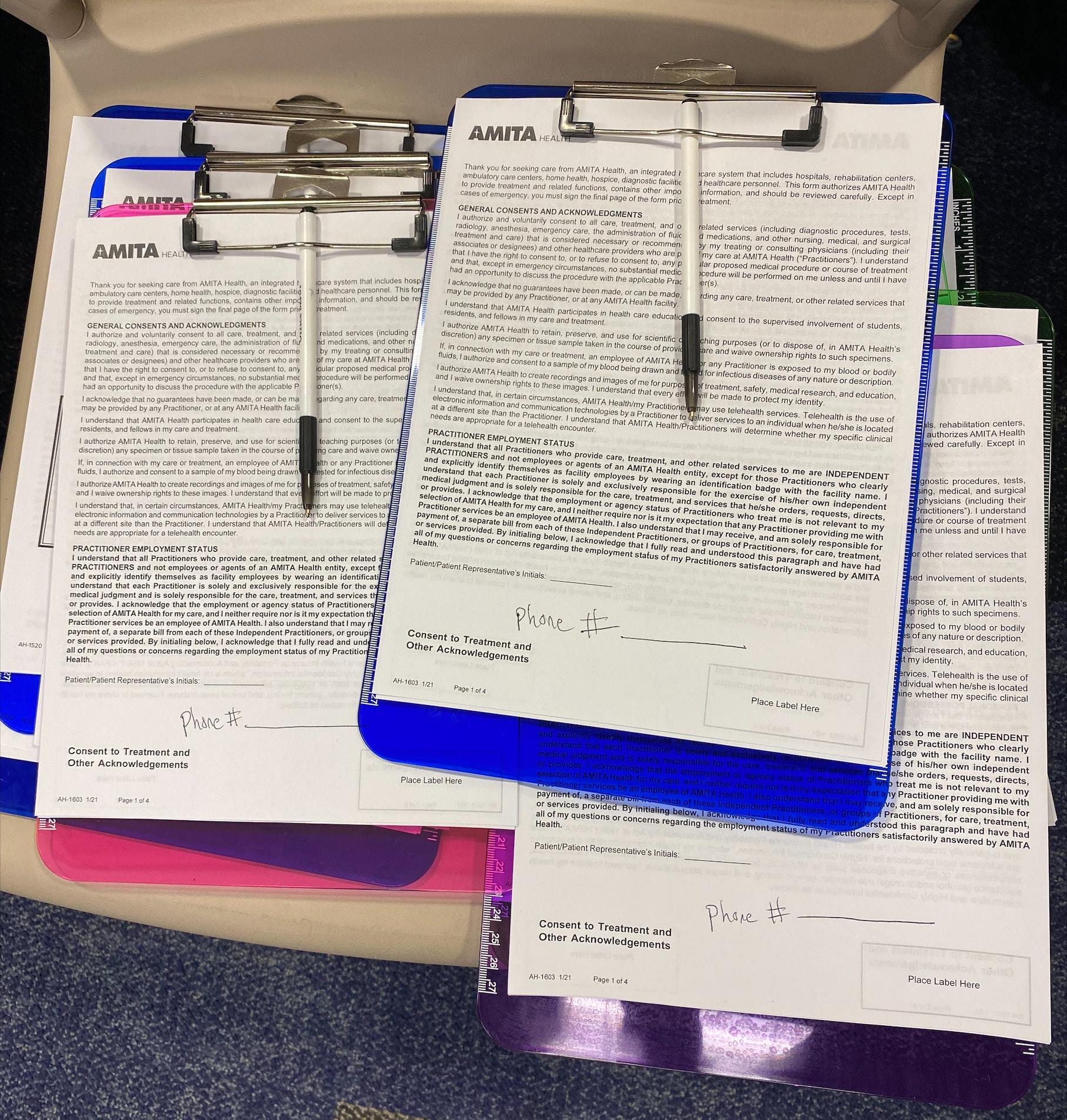

“It is a personal decision to get your shot, but if you are trying to prevent sick ness, this is the first step,” Juarez said.
“Especially if you have roommates or are in the dorms, it is a good idea to stay safe. It hurts a little, but in the long run it helps you avoid being sick for a week and missing out on schoolwork or activities.”
Torres encouraged students to come by the clinic throughout the rest of the clinic openings to ensure they are up to date on all their vaccinations.
“I would tell DePaul students to get vaccinated as soon as possible, and if you have any questions we are here to provide the answers,” Torres said.
“It is a personal decision to get your shot, but if you are trying to prevent sickness, this is the first step. It hurts a little, but in the long run it helps you avoid being sick for a week and missing out on schoolwork or activities.”
Socorro Juarez SAGE clinic staff memberJACOB COSTELLO | THE DEPAULIA Upon arrival, students had to sign medical forms in order to be vaccinated. JACOB COSTELLO | THE DEPAULIA Torres said being able to vaccinate students for free is important because not everyone has health insurance or the ability to afford it.
Riley said.
Riley usually takes the train on her daily commute and will occasionally take the bus to go to work.
“My experiences with the buses have just been worse, like I’ve been late multi ple times when I’ve had to take the bus for things, and I’ve had times where the bus won’t come for 30 minutes,” Riley said.
In the past several months, the CTA has been taking steps to hire more CTA operators, particularly bus operators.
“To address these vacancies, CTA is hiring bus operators at a faster rate than we were in 2019, largely due to recent workforce rule changes we made that al low us to 1) directly hire full-time oper ators versus part-time operators, and 2) increase wages by 5%,” CTA Media said.
In May, the CTA transitioned 315 bus operators from part-time positions to fulltime positions, according to CTA Media. Since mid-August, 84 more bus operators have been added to CTA service.
Despite these efforts, DePaul students are experiencing significant delays with CTA transport.
“I find that the CTA has more prob lems, especially in more non-central parts of Chicago, especially in some of my ex periences in Northwest Chicago, where buses are the only method of public transit out there, they don’t come as often,” Riley said.
While CTA trains are not nearly as un derstaffed as the buses, according to CTA Media, students are still dealing with de lays on trains, especially at night.
One night this quarter, Drinkard was taking the Brown Line home with a friend close to midnight.
“It was supposed to come in seven minutes, then it says ‘due,’... then it says 14 minutes away, so we had to wait again,
To read more about the CTA vacancies and delays, take a look at Opinions page 12.
then it did it again,” Drinkard said.
Drinkard said that the train took 30 minutes to arrive, and that she did not reach home until 1 a.m., despite arriving at the train station at midnight and only having to travel six stops.
The CTA says they are making efforts to address the delays by hiring new oper ators, but it might take several months or more for the CTA to fulfill their schedule.
“Unfortunately, as with all other work forces, just as new hires are brought on board, additional vacancies are being cre ated as a result of attrition,” CTA Media said. “While progress is being made, this is not a matter that will be resolved over night or in a few months.”
The CTA proposed a new $1.8 billion operating budget for 2023 on Oct. 20, with the goal of keeping CTA fares consistent, improving the frequency of CTA transit and “making important investments to upgrade and modernize the system.”
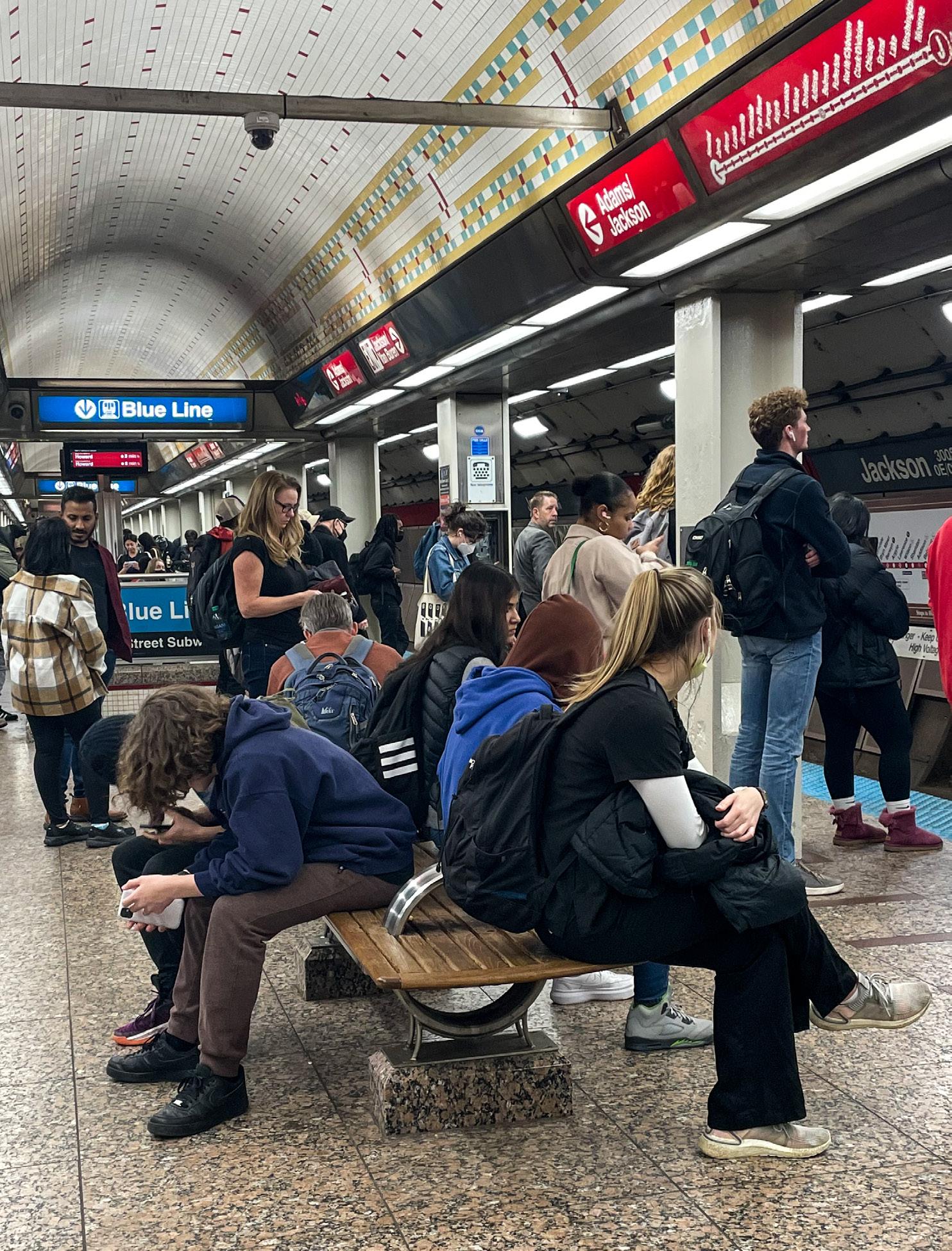

Until the CTA is able to replenish their
staff, students will have to adjust their schedules around CTA delays and absenc es.
“I would recommend people to come maybe an hour early before their classes,” Drinkard said.
However, Drinkard is more concerned about CTA delays that occur after dark.
“If they are understaffed like they say they are, then I’d say at night, plan accord ingly, because it can get scary,” Drinkard said. “I got lucky with my friend.”
“It was supposed to come in seven minutes, then it says ‘due,’... then it says 14 minutes away, so we had to wait again, then it did it again.”
Kalixta Drinkard DePaul junior
Students Against Incarceration (SAI) held a general body meeting on Wednes day, Oct. 19.
SAI is focused on renewing past activ
Ghanem.
Ghanem responded to their work, noting the strides DePaul has made in the movement. But citing why they are not able to completely “ban the box”.
"In the last couple of years alone, De Paul has considered and conditionally admitted applicants with self-disclosed backgrounds including possession and dis tribution of drugs, DUI/DWI, and theft,” Ghanem said to the members of SAI in 2019. “On the other hand, DePaul has also considered and denied applicants with backgrounds involv ing mur der, pedophilia, kidnapping, and rape."

The club's advoca cy has also included organizations to end cash bail, book club with incarcerated people, incarcerated penpals and other activism regard ing incarceration and voter mo bilization.
The work SAI has done
with their incarcerated book club brought people out to see what the organization had to offer.
“I saw that they did book clubs with incarcerated teenagers,” sophomore Chev’anique Edwards said, “I want to be part of that, so I came to the meeting. I'm enjoying myself so far.”
For Co-President Nana Ampofo and other students– their call to join was the opportunity to help others.
“I'm just very passionate about this work,” Ampofo said “It made my pas sion deeper to help other people whether through art or any kind of service that I can do. So I feel like this club was like the best club for me because it allows me the space to create actual initiatives”.
The organization made waves to help the DePaul commu nity by mobilizing via social media in support of
Chartwells dining employees, negotiating with DePaul for higher wages and health care coverage.
This year they are poised to renew their efforts to ban the box. In addition, they hope to continue their other activism in cluding book club and other abolition and get-out-the-vote efforts.
Their mission is centered in creating a community where people interested in fighting issues concerned with the crimi nal justice system can be educated and take action. In addition, the members hope to mobilize DePaul students and hold DePaul accountable for its role in the prison indus trial complex.
Leadership calls for more students to try out the organization.
“Just come to one meeting,” Hofstra said. “Just come to one and see if it's something that you are interest ed in or care about or just some thing you want to be participating in.”
Students who came to the meeting felt like there was a lot to gain from the orga nization.
“[I got a] better understand ing of where DePaul University can improve and how they can, you know, positively impact the movement that students against incarceration is trying to convey,” Edwards said.
Students who would like to attend future SAI meetings can find the organi zation on Instagram at @saidepaul.
Salma Ghanem DePaul Provost“In the last couple of years alone, DePaul has considered and conditionally admitted applicants with selfdisclosed backgrounds including possession and distribution of drugs, DUI/DWI, and theft.”
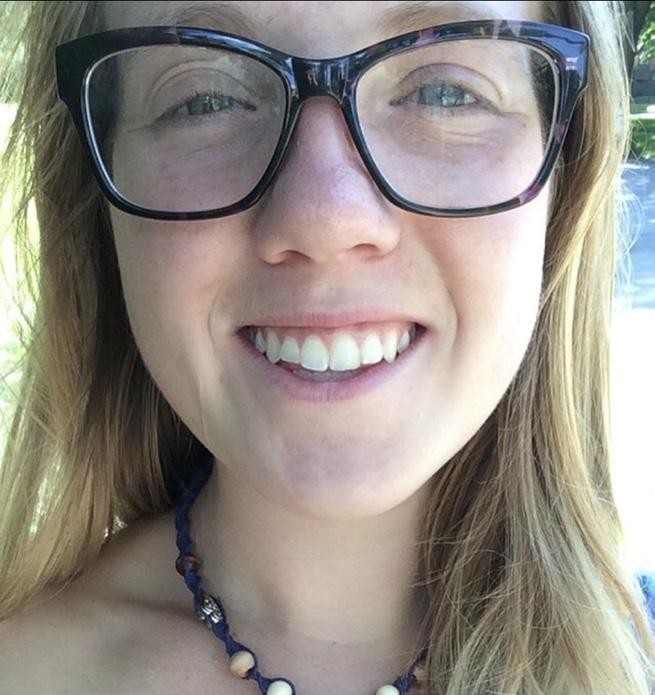

Student Government Association (SGA) held a Meet the Candidates event on Thursday, Oct. 20.
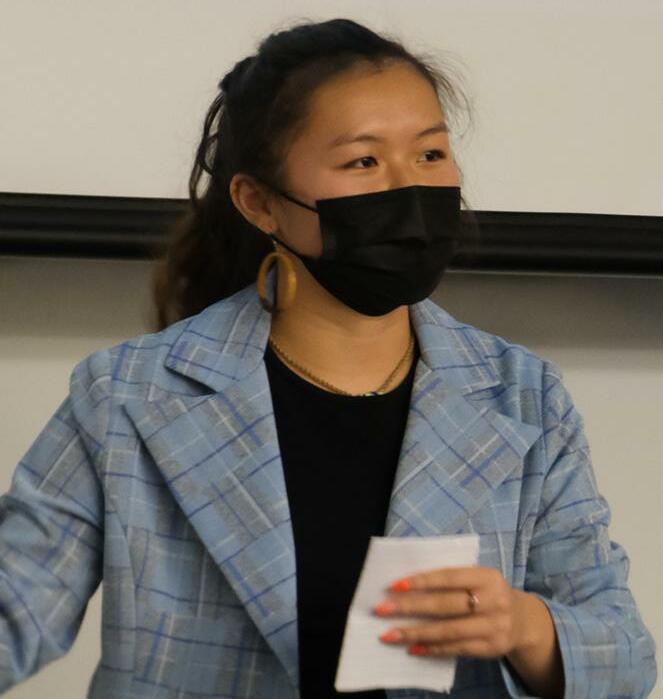
The event allowed students, both in volved in SGA and not involved, to meet the students who are running for open senator positions. The open positions are: Senator for Graduate Students, Senator for Transfer Students, Senator for The atre School, Senator for College of Law, Senator for Mission & Ministry, Senator for Sustainability, Senator for First Gen eration Students, Senator for Community & Government Relations, Senator for In ternational Students and Senator for First Year Students.
At the event, candidates told students about why they chose to run for their de
sired role and why they are the best candi date for that position.
Below, readers will find a list of candi dates who are running for each position. As of now, there are students running for Senator of Mission and Ministry, Senator for Transfer Students, Senator for Inter national Students, Senator for First Year Students, Senator for First Generation Students, Senator for Community and Government Relations and Senator for Sustainability. The positions of Senator for Graduate Students, Senator for Theatre School and Senator for College of Law will remain open.
Elections for open positions may take place throughout the year. During the spring quarter, students will be able to vote on and run for executive positions, officer positions, senator positions and other representative roles.
Students can vote in the election on DeHUB and can register to be in the elec tion portal now so they are able to vote faster once the ballot is released. When students register to be in the election por tal, they will be reminded of the student government elections that occur through out the year and in future academic years.



The ballot will be released on Oct. 27, and students have until 5 p.m. on Nov. 1 to vote on the candidates.
Results for the election will be released at noon on Nov. 2. They can be found on SGA’s Instagram page @sgadepaul.
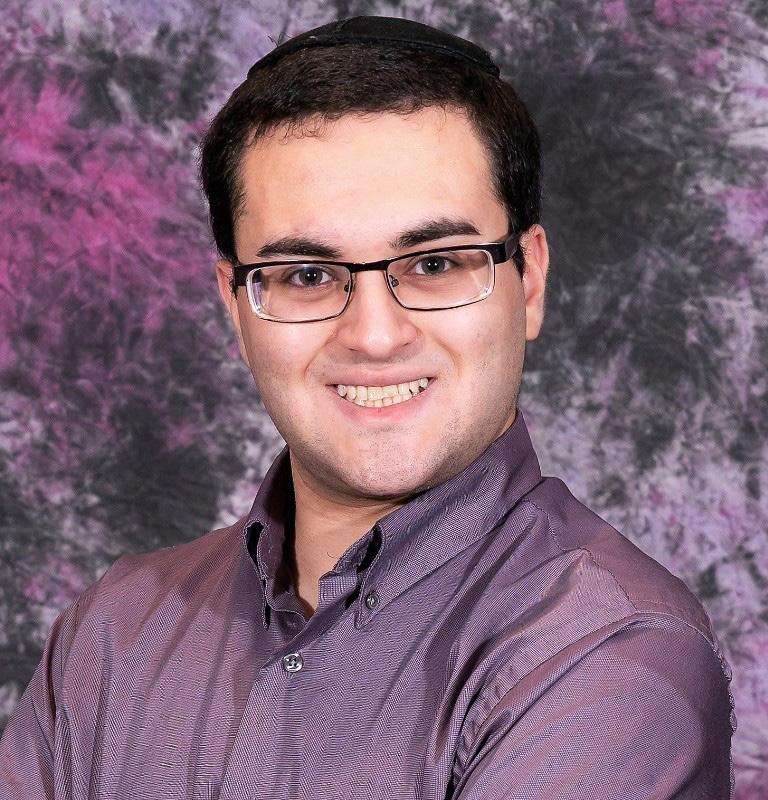

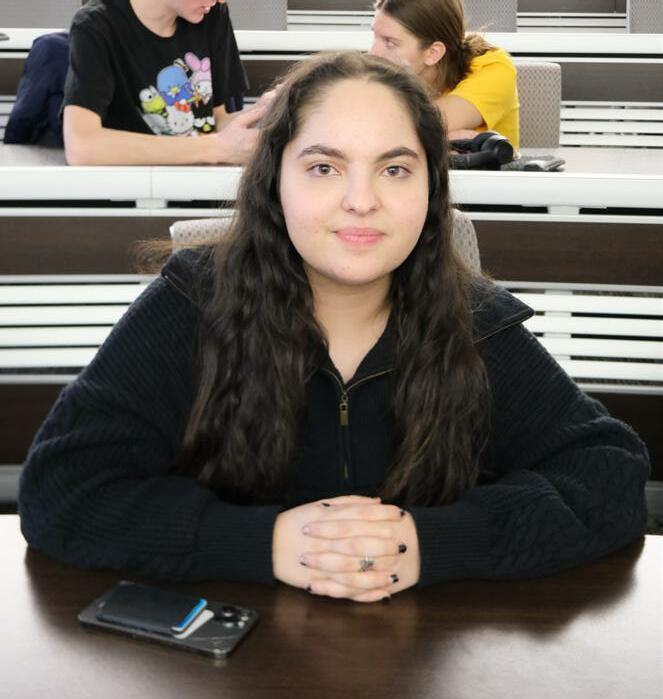

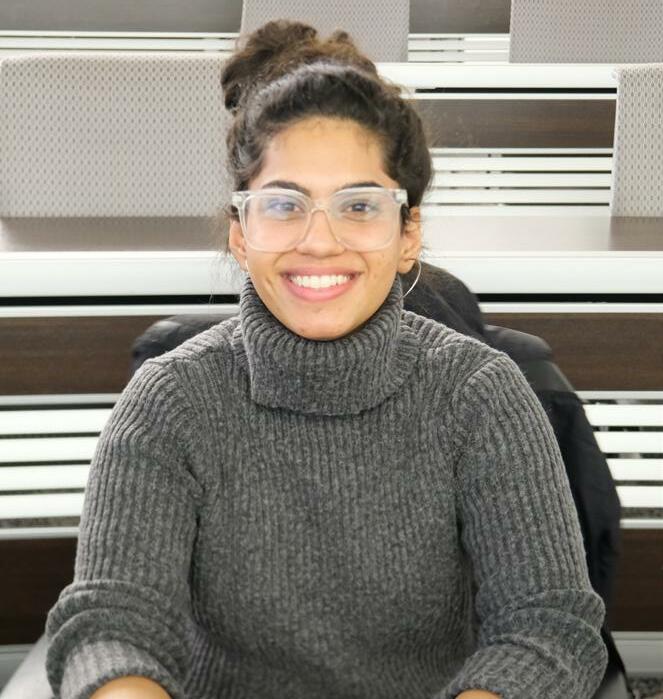


To celebrate this Halloween season, the DePaul Activities Board (DAB) threw a Hal loween Party on Tuesday, Oct. 18.
The Halloween party was held in the LPC Student Center atrium from 2 p.m. to 5 p.m. The event included trick-or-treat buck et decoration, wood sign creation and sweet treats, via DAB.
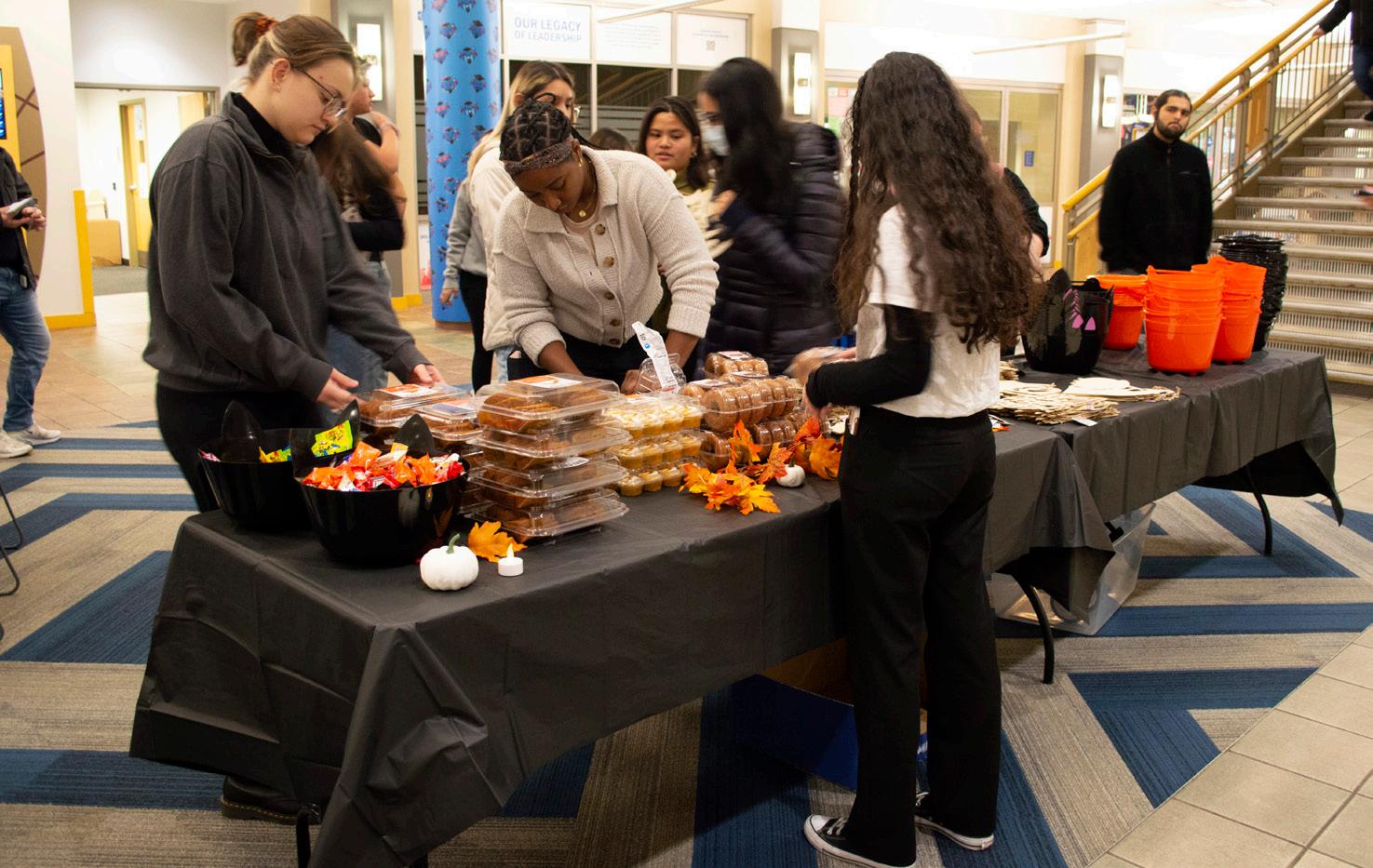
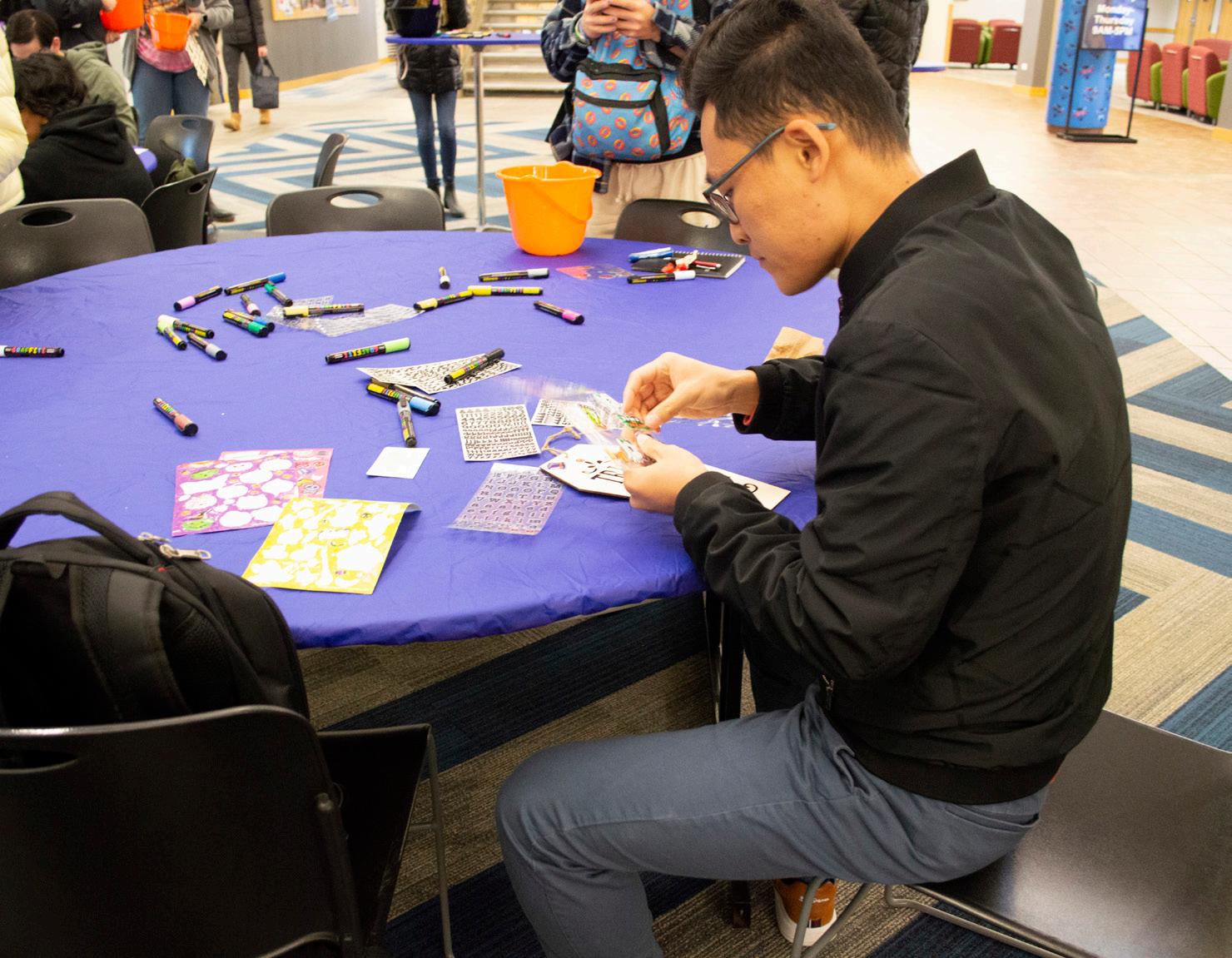
Freshman Mallis Boonner and many other students were excited to kick off the Halloween season.
“Halloween is my favorite holiday, so I wanted to come out to celebrate,” Bonner said.
As a college event, the opportunity for free things always draws a crowd.
“I really just came out for the free stuff,” freshman Victoria Rueda said.
With the variety of events offered, there is something for everyone.

“I love events that get put on,” Bonner said. “I try to go to as many as I can, there’s always something I'll enjoy, even if it’s just the fact that there’s free stuff.”
Following the fall kickoff, DAB wanted to put together an event to celebrate the Hal loween season.
“I wanted something that was going to be interactive with the holiday season com ing up,” DAB Signature Events Chair Carina Risiglione said. “I think we should do some thing that is still craft and that people can engage with, especially with trick or treating, and having food like sweets, of course, and then painting your own sign that I thought would be sweet for freshmen to put up on their dorms.”

The halloween sign decorations includ ed stickers and markers for students to dec orate while eating pumpkin loaf and donuts.
Students like international student Lu Heng, were even celebrating their first Hal loween.
“I’ve never seen this kind of activity, or even Halloween, because in China we don't have this kind of event,” Heng said. “I came to this event because I just wanted to see what was going on for Halloween. I want to be a part of the culture.”
The next Halloween event being held by DAB is “Harry Potter Halloween” being held on Oct. 25. More information about DAB events can be found via their Instagram @ DAB_DePaul and all events are listed on DeHUB.
“I’ve never seen this kind of activity, or even Halloween, because in China we don't have this kind of event. I came to this event because I just
to see what was going on for Halloween. I want to be a part of the culture.”
Lu Heng International student
She’s impacted the lives of countless DePaul students through her passion, grit, and encouragement. She’s a leader who loves what she does and embodies DePaul's mission daily.
Courtney James, DePaul's director of the Office of Student Involvement (OSI), was named one of the university's 125 faces. The 125 faces highlight and celebrate 125 notable people who have inspired the DePaul community and used their influence to build a better fu ture for the university.
Patrick Rezek, OSI coordinator for fraternity and sorority life and Demon THON, says that it is no surprise to him that James is one of the 125 faces.
“Courtney has so much institutional knowledge of DePaul, and she has such a passion for her work that it’s infectious,” Rezek said.
James oversees several of the core functions for campus activities, student organizations, fraternity and sorority life and the university’s Big East Esports program.
Numerous students look forward to events like the ugly sweater party, the tree lighting ceremony, and midnight breakfast, whether it is for a free treat or DePaul swag. For James, it is where her hard work is showcased.
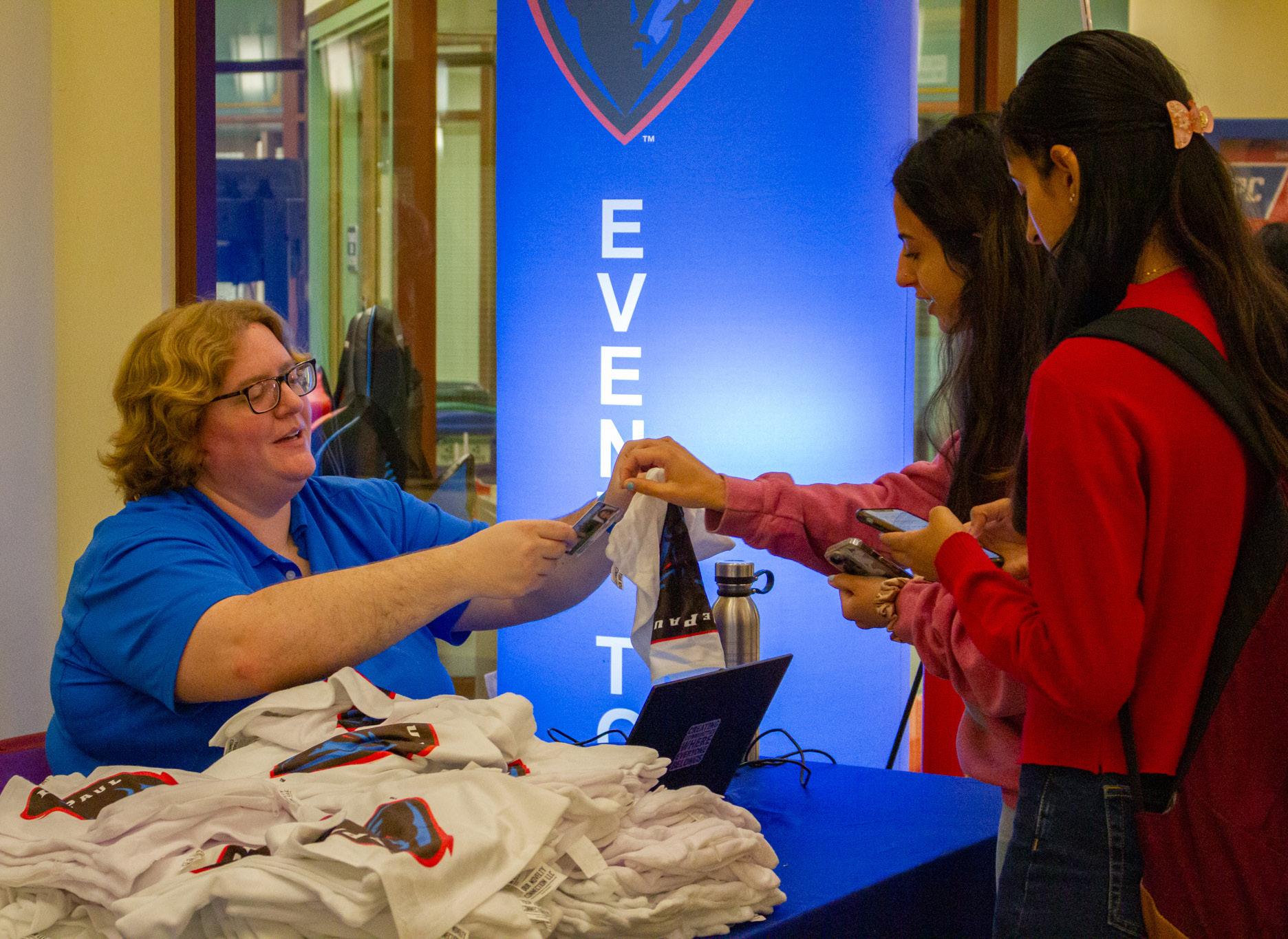
“She's a go-getter,” said OSI’s finance assistant, Mayra Encarnacion. “Some one who can see a vision and make it happen for any DePaul event.”
James has been employed by DePaul for seven years and is currently pursuing a Ph.D. in higher education at DePaul. She was overwhelmed when she learned she was one of the 125 faces, but she also felt a sense of accomplishment because of how hard she had worked for the past
“I love DePaul. I hope to have a long career at DePaul, DePaul has made me feel like I belong here to make a posi tive impact on the lives of others,” James said.
In seven years, James has helped grow OSI to what it is today. In James' work planning events, all she wishes is for attendees to leave with a new friend and everlasting memories.
Ald. Timmy Knudsen (43rd) released a statement via email Thursday in response to the fatal shooting at Hotel Lincoln’s rooftop bar in the early hours of Oct. 16.
In the statement, Knudsen said that he’s been in “consistent communication” with CPD Commander Jon Hein of Dis trict 18, who is overseeing the investiga tion.
“Our Ward office will communicate specific details once the investigation is complete,” Knudsen said in the statement. “We send our love to the victim’s family, the hotel staff, and all of the police officers working diligently on this case.”
Over the weekend, the hotel’s bar re mained closed per request by Ald. Knud sen’s office.
“After speaking with CPD and hotel management, Hotel Lincoln’s rooftop bar will remain closed to the general public through the weekend at Ald. Knudsen’s re quest,” said a statement sent via email Fri day by the Lincoln Park Alderman’s office.

The shooting took place in the early morning hours of Sunday, Oct. 16, when 35-year-old Cordayl Allen was involved in a fight at the rooftop lounge. According
to CPD, Allen was shot in the chest and taken to Illinois Masonic Medical Center, where he died from his injuries.
No arrests have been made.
In Knudsen’s communication sent out Thursday, he remarked on the importance of the city working together to curb gun violence. Knudsen’s email also included figures for the city’s 2023 budget that are committed to public safety, like the $64.3 million increase in CPD’s budget next year.
Knudsen also mentioned the CPD’s proposal to receive funding for an increase of 35 positions, and added that he would like to know more about how the depart ment plans to fill the open roles, as staffing has been a major concern in recent years.
“Of these funded positions, there are many vacancies, and I look forward to questioning CPD tomorrow [10/21/22] on their strategy for increasing hiring,” Knudsen said.
The 2023 budget will also include an 8.1% increase for the city’s Office of Public Safety and Administration.
Thirty DePaul freshman students had the chance to meet with Knudsen during a visit to city hall last Monday. The out
“It really means a lot that this came from DePaul, because our communi ty, our values, everything means a lot to me,” James said. “I was fortunate to know some of the people who nomi nated me and read the nice things that others said about me, and to know that others think I have an impact at DePaul, is very rewarding.”
James works with countless num bers of students, staff and faculty daily,
including her workers at OSI, who have come to appreciate and value her as a boss and a role model.
“She’s a champion of Vincentian per sonalism in her everyday work and in spires her staff. She constantly embodies our mission and ideals of always asking, ‘what must be done.’ I am proud and honored to work with and learn from Courtney every day in OSI,” Rezek said.
ing was part of an Explore Chicago class, known as “Chicago Politics: Bosses and Reformers.” During the visit, students discussed the process of budget hearings with Knudsen and sat in on a budget hear ing for the Chicago Department of Public Health.
In Thursday’s emailed statement, Knudsen said he was motivated by the stu
dents’ interest in improving the city.
“Meeting these students, I was ener gized by their curiosity and how deter mined they are to get involved to better our city,” Knudsen said. “We are so lucky to have tens of thousands of students at all levels and ages learning in our 43rd Ward every day.”
With midterm elections approaching in three weeks, more and more informa tion has been thrown around online. The DePaulia thought it would be helpful for students to have a guide to follow that breaks down important pieces of advice for everyone to make the best decision.
While this seems explanatory, it is important for students to decide where they should use their vote. Do the poli cies happening in your hometown matter more to you then voting on what happens to Lincoln Park while you are living here? There is no right answer but it is import ant to think about if you plan to go back home after college or stay.
Chicago GOP Jeff Fieldler’s advises students to make a decision where they should use their vote.
“So, the first thing they have to do is to figure out whether they are going to be registered to vote, where they’re from, or where they’re at for the next 2 to 4 years,” Fielder said. “Politics at a local level is much more interactive with people who live in the neighborhood of politics at a national level.”
Piece of advice #2: Find out if you’re registered and where your polling station is
It seems stressful, but it is very acces sible checking to make sure you are regis tered to vote in your area as well as where you can go Nov. 8. Your voter registration doesn’t automatically change when you move districts, but there is still time to update.

Emily Long, a Junior majoring in po litical science at DePaul believes one of the biggest pieces of advice is planning out beforehand where you are voting and that you are officially registered.
“I have so many friends who just as sumed it would be registered and that was so easy but ended up not being able to vote because they didn’t check,” Long said. “There’s also a lack of accessible polling spots for disabled people, it’s bet ter to make sure beforehand because it’s surprisingly not most of them.”
While there are multiple new sourc es you can trust for information, a great resource for none biased election infor mation is Ballotpedia. Ryan Williams, President of DePaul’s College Republi cans believes students should focus on fact checking and researching for them selves instead of relying on outside infor mation.
“The biggest thing is just for people to know what’s going to be on the ballot and who they’re voting for. There’s a website called ballot pedia.org and you can type in your voting address,” Williams said. “And it will show you everyone who’s going to be on your ballot, what they’re running for. That’s just that’s a great re source just to know ahead of time like, what you’re going to be voting for.”
A main piece of advice is paying at tention to local politics. From aldermen to the County Board of Commissioners, these candidates affect the most of stu dents’ everyday life.
“They know there’s a president, they
know there’s the Senate and governors but they don’t have any idea about the guy down the street that’s running for the Illinois House or the Senate or the Coun ty Board of Commissioners,” Fielder said. “Those are people that make decisions that impact their day to day life living at DePaul.”
Injustice Watch recently created a Cook County Judicial Election guide to help Chicagoans make a more informed decision on the 61 judges who are run ning for retention. Included in the guide

is researched information covering past controversies, notable reversals, ratings and if a judge was a former prosecutor or public defender.
Jonah Newman, the managing edi tor for Injustice Watch thinks students should focus on the policies that affect them locally, like circuit court judges.
“We like to say that judges are the elected officials that people are most likely to come into contact with wheth er that’s because you got a traffic ticket, and you’re contesting it or maybe going through a divorce or settling the estate



Voting on a politician’s values is an important way to find out who to vote for if having difficulty with deciding.
“It’s not about voting republican or democrat, it’s better to focus on what policies are going to affect you and what you vote for now will change how we live five-ten years from now,” Fielder said. “We are seeing that now with programs

in the state of Illinois and from a finan cial standpoint that we can’t ignore the money they’re spending now and what’s going to cost us.”
Newman also wanted to include fo cusing on what the politicians stand for is key to deciding who to vote for.
MAYA OCLASSEN | THE DEPAULIA of someone who has passed away, and there’s all kinds of ways of facing eviction or foreclosure,” Newman said. “There’s all kinds of ways that judges come into our lives and their decisions affect peo ple’s lives. And so we just want to make sure that people are making choices about who sits in this position.”
“I think that’s true of how [elections] get covered in the US, but there’s a lot of that like the horse race result was down. Who made this comment, who said the wrong thing, rather than really looking at all of the positions the candidates have on issues,” Newman said. “So I think that’s what I would suggest is looking for voter information that really focuses on that candidate’s policy. I think in the gov ernor’s race, policy divisions are pretty stark and obvious and so being informed about where the candidates fall on issues that matter to you, I think is really im portant.”
On weekdays from 8:00 a.m. to 9:00 a.m., CTA Blue Line trains are sched uled to arrive every three minutes. In my opinion, three minutes is a very reasonable amount of time to wait for a train. Only someone as chronically late as myself could not afford to wait just a few minutes on the train platform before arriving at work or school.
However, thanks to recent data pub lished by the Commuters Take Action group, we are able to see the true state of the system. The group observed the arrival of trains from different stations across the system, and compared their observed fre quency to the claimed frequencies on the official CTA schedule. I find the results to be frankly pathetic. In this window on the Blue Line during which customers are to expect a train to arrive ev ery three minutes, trains actually arrive on average every six minutes.
On Saturdays, from 10:00 a.m. to 11:00 p.m., trains are scheduled to appear every eight minutes, but in re ality, only make an appearance every 22 minutes on av erage. We as riders deserve better.
The truth is that it has not always been this way. Before Covid-19, the CTA maintained a pretty respectable level of service. Having only moved to the city during the tail end of the pandemic, these stories of the train being the fastest option for commuting to the airport, for example, are unfortunately just tales of a bygone era for me. To better understand why the system has been so bad lately, I spoke to a longtime CTA employee who requested to remain anonymous.
“We had a lot of people who quit and
The
retired because they weren’t vaccinated or didn’t want to deal with people who weren’t vaccinated,” the CTA employee said. “Covid hurt us really badly, and we’ve been trying to pick ourselves up over the last seven or eight months.”
The city’s administration clearly had its views when it came to Covid-19 and the vaccination. I certainly do too. Though I have been procrastinating getting my next booster shot, I am a strong proponent of the Covid-19 vaccines; however, I am not a strong proponent of the city prior itizing its own progressive agenda over the well being of the city’s transit system. I suspect the city failed to consider the long term implications of their myopic vaccine requirement, and now it is our job as riders of the CTA to bear the burden of their short sighted actions.
My source at the CTA claimed that from last year to June, the or ganization lost over 700 people. As any CTA customer could recite verbatim to you thanks to the incessant PA alerts, the CTA’s official stance is that “Some service may be running with delays: Staff availability is affected by COVID but we're running as much service as possible—wait times may be longer than usual.” Notably omitted from this “special alert” is the fact that this acute shortage of bus and train operators, the main reason for the CTA’s present issues is a direct result of the CTA’s own policies.
In addition, many riders have ex pressed safety concerns about the CTA lately. CBS News Chicago found that “vio lent crime on CTA's buses have remained largely the same the past several years, while crimes on the train have increased
in this
steadily to highs not seen since 2011.”
“You used to have two to three conductors per train on the CTA,” the CTA employee said.


He said once the CTA started running trains with just one conductor, locked away from the passengers in their own compartment, “everything went to hell”.
This inability to properly staff its trains is a massive issue for the CTA and its rid ers, and is certainly one that needs to be better addressed.
“Rail automation has been the worldwide way for ward in terms of increasing train service,” said Brandon McFadden, a cybersecurity analyst in Chicago. “Rail automation would be great to increase consistency.”
In a city as pro-union as Chicago, it is no wonder that an organization that is an arm of the city finds itself a prisoner of these very unions.
“They won’t automate them,” the CTA employee said. “It’s a union city.”
There seems to be a theme that the city and the leadership at the CTA prioritize political agendas over actually operating an efficient transportation network. These are just a few causes of the many issues the CTA currently has, but one thing both McFaddenand the CTA employee agreed on is that the CTA lacks transparency. The true portion of CTA issues that can be attributed to staffing shortages is anyone’s guess. It is highly likely that a large portion of these problems are due not just to lack of personnel, but to poor management from the top down.
“The CTA has always been an exten sion of city hall… It’s where the mayor puts all her cronies… It’s a gentlemen’s club,” the CTA employee said.
It’s clear that the system has issues, and we as riders deserve better. It’s up to us to demand more. If I were to walk into Pequod’s tomorrow, craving a deep dish
pizza, and I was promised a wait time of 20 minutes for my pie only to be waiting 55 minutes later with my pizza nowhere in sight, I would be quite upset. For any business, customers expect a decent level of service, especially when a certain level of service is promised to them. When a business fails to meet this level of service, customers are absolutely justified in being upset and taking their business elsewhere.
The keen readers amongst my audi ence here may now recall the fact that the CTA is a government entity, originally formed by the merger of several different private train lines in 1947. Since then, Chicago’s transit system has been effec tively immune to these market forces that normally hold companies accountable. Given the acute lack of these market forc es, it is the responsibility of the citizens of Chicago and the elected officials we elect to hold the CTA accountable. The ball is in our court.
reflect those of The DePaulia staff.
QUENTIN BLAIS | THE DEPAULIA The Sheridan Red Line station is empty on a Tuesday evening at 6 p.m. Riders have been taking the CTA less frequently due to longer wait times and inconsistent train schedules since the pandemic.“You used to have two to three conductors per train on the CTA, [then] everything went to hell.”
Anonymous CTA employee
Students, faculty frustrated with CTA inconsistency
 By Jake cox Staff Writer
By Jake cox Staff Writer
DePaul freshman Ella Wheaton steps off the train, finally arriving in Lincoln Park after a grueling night class in the Loop campus. She’s eager to get a quick meal from the dining hall; but for Whea ton, it’s not that simple. By the time she arrives back in Lincoln Park, the dining hall is closed. Her other option, 312 Din er is, per usual, packed. Exhausted and frustrated, Wheaton bites the bullet and resorts to a frozen meal from ETC.
The dining hall should be open later to accommodate students' hectic sched ules. There should not be a choice that has to be made between getting a meal and going to class. In addition, it makes assumptions that all students are going to eat at small windows of time. If they choose not to, they are forced to use their own money, an unreasonable expectation for college students.
“I have a night class on Wednesday nights, and it ends at nine and it's at the Loop, so by the time I get back it's like 9:30 p.m.,” Wheaton said. “I think closing at eight does not accommodate people who have night classes, and I know quite a few people who have night classes.”
This sentiment rings true for fresh man Ava Maginity.
“The hours are a bit frustrating,” Mag inity said. “The general dinner hours are inconvenient when I have night classes.”
There are a few more options for students, but they are not ideal. The 312 Diner is open until 10:45 p.m. Monday through Thursday and 9:45 p.m. on weekends. From limited options to long lines, students cannot be expected to resort to 312. Transit (Quality Meals to Go) is open an hour longer than the main dining hall, closing at 9 p.m. but with a short menu and not being open on week ends, it’s not much of an option.

“By the time I get back, the only thing open is 312 which has a crazy long line,” Wheaton said. “It’s the only one open, and I'm generally very hungry at the time, so I end up just going to ETC, the convenience store in the LPC Student
Center.”
Another concern of students is the dining hall drastically limiting meal options during non-peak hours. Stu dents are all paying the same one meal swipe for access to very different options depending on when they decide to get a meal.
“The options are so limited in the food they’re serving between the hours of like 10 a.m.-11 a.m. and 2:30 p.m.- 4 p.m. because that's when they change meals. But that's usually when I get lunch and as a vegetarian there are virtually no options,” Maginity said.
In addition, the dining hall doesn’t open early enough to accommodate students with morning classes. Students should have the opportunity to get a meal before class if they want one.
“I know people who have morning classes and that's [dining not opening until 8 a.m.] is an inconvenience for them if they wanted to get food beforehand,” Wheaton said. “It is a whole other thing to use your real money and go shopping and get breakfast and things like that.”
For students who wake up early on weekends, the same tune is repeated.
“Weekend breakfast hours should definitely start earlier,” Maginity said. “Food should be accessible for people at the start of their days, and opening break fast at 10:30 a.m. makes that difficult.”
Another concern is the money stu dents waste by being unable to use their meal swipes because they frankly do not have enough time in the day to use them.
When asked, “Do you usually use all of your weekly meal swipes?” via a Snap chat poll, 288 students responded. Out of the responses, 234 students responded “no.” The respondents were all DePaul freshmen.
While this result could be attributed to other factors, one of them is the hours not being accessible to all students.
On the flip side, many students are satisfied with the services provided by dining, while empathizing with other students.
“I’m not someone who likes to eat su per late at night anyways, and I don’t eat
breakfast so the current times suit me well, but I can understand how it would be nice to have longer hours,” freshman Lily Wening said.
However, ac cording to dining hall management, students haven’t expressed these concerns to staff.
“I spoke with staff from Hous ing, Dining, and Student Centers,” director of hous ing, dining, and student centers Rick Moreci said. “All I have spoken with have said that they have not received any feed back about dining hours at all from students.”
While this is import ant to note, it doesn’t diminish the complaints students have expressed informally.
Students who would like to express their concerns on this issue may reach out to the student center or dining hall management staff. Feedback can be submit ted here.
In comparison, Loyola University Chi cago has dining halls open until 11 p.m. on weeknights. A far cry from DePaul’s 8 p.m. Loyola dining also opens at 7:30 on weekdays, and 8:30 on weekends. These hours are far more accommodating than what DePaul currently offers.
The bottom line students are feeling that their experience dining at DePaul is not as accessible as it should be. The
hours should be expanded to better reflect the busy schedules of college students. Especially for students who live on campus, and are required to have a meal plan. We deserve to get what we are paying for and have convenient access to dining at DePaul.
“Right now, it's inconvenient when dining halls should be convenient,” Wheaton said.
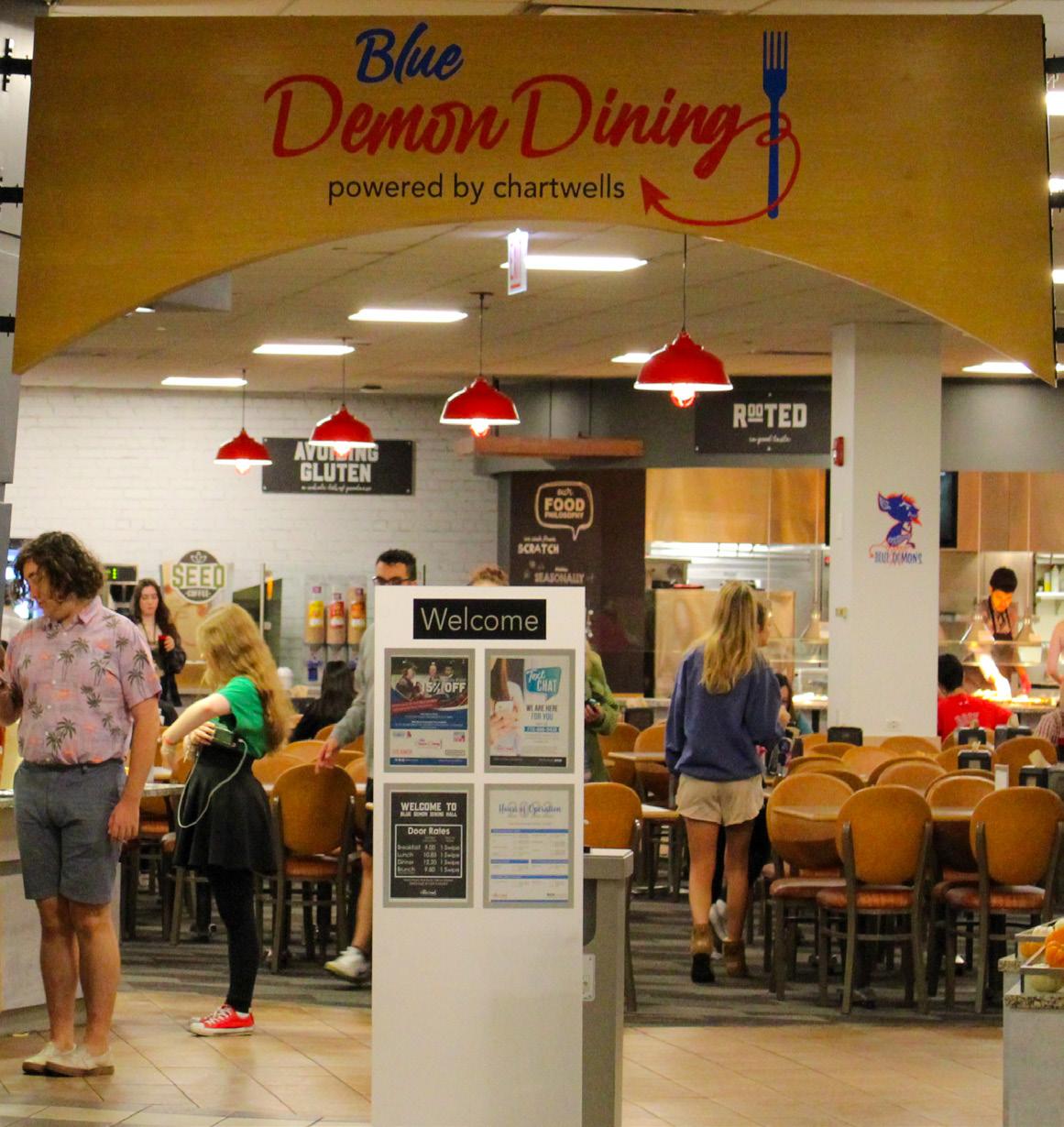
There is no shortage of hot-button issues for voters to consider when going to the polls this election season, but that does not mean they have to do irreparable harm to your relationships.
Voters nationwide are noticeably divided on issues of inflation, economic stability and abortion. As political polar ization has built steam in recent years, it has become commonplace for political leanings to negatively affect personal relationships. A New York Times/Siena College survey found that 14% of voters believed political views revealed a lot about whether someone is a good person, and almost 1 in 5 said political disagree ments had damaged relationships with friends or family.
In a 2020 NPR story, Jocelyn Kiley, associate director of research at the Pew Research Center, said that according to the organization’s research, political po larization has become more acrimonious than any other point in modern history. Nearly 80% of Americans now have "just a few" or no friends at all across the polit ical divide.
In its purest definition, democratic voting is not intended to be an overtly emotional exercise. The point of giving every legally eligible citizen the vote is that, ostensibly, they would support candidates that benefit themselves and the public good.
As a registered voter and some one who considers themselves aware of important issues, I also fully understand that not everyone entering a voting booth shares the same values and opinions I do. In social and professional situations, I do not go out of my way to start debate as political differences can build barriers between casual acquaintances and close confidants alike. Even the most passive of people understand the level of polariza tion that has become synonymous with American politics.
What has been lost, it seems, is that it is acceptable to have differences that do not necessarily cripple relationships.
Do you feel vindicated to vote against your perceived opponents? Relieved be cause you would feel guilty if you did not? Disappointed because you know your vote is incongruent with others in your life?
Just as your life experiences influence who you vote for, they affect how you
view the electoral process. Living in a metropolitan area your entire life is just as likely to prompt your political stances as growing up in the small and often ethni cally homogeneous towns that dominate Illinois outside of Chicagoland.
Could someone disagree with you and turn out to be a bad person? Of course. But just as I would encourage everyone to take advantage of the privilege of par ticipating in a democratic election — as fraught as that concept is these days — try not to let your ballot disproportionately affect other parts of your life.
If you are not registered and want to take advantage of the opportunity to vote, you can register online here. Convenient ly, if you are not sure where to vote, you can search online to find your nearest polling place.
All told, do what you feel best about for yourself and, if you do vote, for the people around you, even if they disagree with you. Early and absentee voting is open now, and Election Day is Nov. 8.
While strolling through an antique shop in early January 2015, Chicago res ident Andrew Clayman noticed a pale green kitchen scale sitting on one of the store shelves. Although drawn at first to its faded, worn-out face, Clayman made a life-changing discovery that would ulti mately send him down a rabbit hole.
Barely visible among the faint letter ing on the 1930s Pelouze Family Scale’s dial was one pivotal word: Chicago.
“I didn’t give it much thought right away, but then one day I decided it would be cool to look up the history of the ob ject,” Clayman said. “It was kinda fun going down the rabbit hole of where it came from. So I got a couple more objects, and after the snowball effect of growing my own collection of ‘Made in Chicago’ things, I realized that if I thought this was interesting, maybe others would agree.”
Following this revelation, Clayman launched his own “Made in Chicago Mu seum” website with the original intent of briefly documenting the Windy City roots of the few objects that he had accumulat ed.
Attending the museums for the first time, Turkey-born native turned Chicago resident Barkin Kurumoglu was struck not only by the sheer volume and history of both displays, but also the passion visi ble in each exhibit.
“Back home in Ankara [Turkey], unfortunately, for various factors, once something becomes considered old and obsolete, it’s kind of just left alone to ‘be there,’” Kurumoglu said. “Across the city of Chicago, people are proud to say that they’re from here and the pride is the difference. There’s so much about Chica go architecture that sticks out to me, and the idea of being mindful of the past and cherishing the memories rather than just moving forward with time feels special.”
As his site traffic and personal archives began rapidly increasing in number in 2017, Clayman realized he needed to share
his growing, already hundreds-strong, collection with the world. At this point, Clayman’s entirely self-funded collection of Chicago memorabilia began a tour of various downtown historical societies, with the website acting as a mobile “tour guide” for the static exhibits.
Following the onset of the Covid-19 pandemic in early 2020, Clayman’s col lection spent nearly two years in storage. Now, with the pandemic largely in the rearview mirror, Made in Chicago found hopes to be a new long-term partner in the vibrant Belmont-Cragin neighbor hood, located at the expansive campus of Klairmont Kollections. Kollections is a museum consisting of “over 300 of the most stunning, impressive, and clever ve hicles any car enthusiast could hope to see during their lifetime,” according to their website.
Within the vast halls of Klairmont lies an automotive and aviation mecca, packed to the ceilings with rare vintage cars and airplanes, brightly-colored post ers and neon signs flashing as far back as the early 1900s. Like Clayman, current Klairmont President Robert Olson sees his 100,000-square-foot museum as a hid den gem for fans of Chicago’s illustrious history.
“We love Chicago,” Olson said. “It was a Mecca for industry, manufacturing, the steel mills, the stockyards. Chicago could do everything. Anything that we can do to celebrate Chicago we’re all about, and we thought there’s no better way than to pro vide a smaller museum that actually had hometown items.”
At the end of 2021, Olson found Clay man’s archives via a Facebook promotion al video and immediately invited him into the vacant space next to Klairmont Kollec tions founder Larry Klairmont’s own me morial. This exhibit dedicated to the late Mr. Klairmont, who passed away in July 2021 at the age of 94, celebrates his life as a World War II veteran and Chicago real
Ana Mercado is the Event Specialist for the Klairmont collection. The collection got its start as a private storage facility.
Following the launch of Clayman’s space within his museum, Olson began spotlighting the automotive industry’s own Chicago connections.
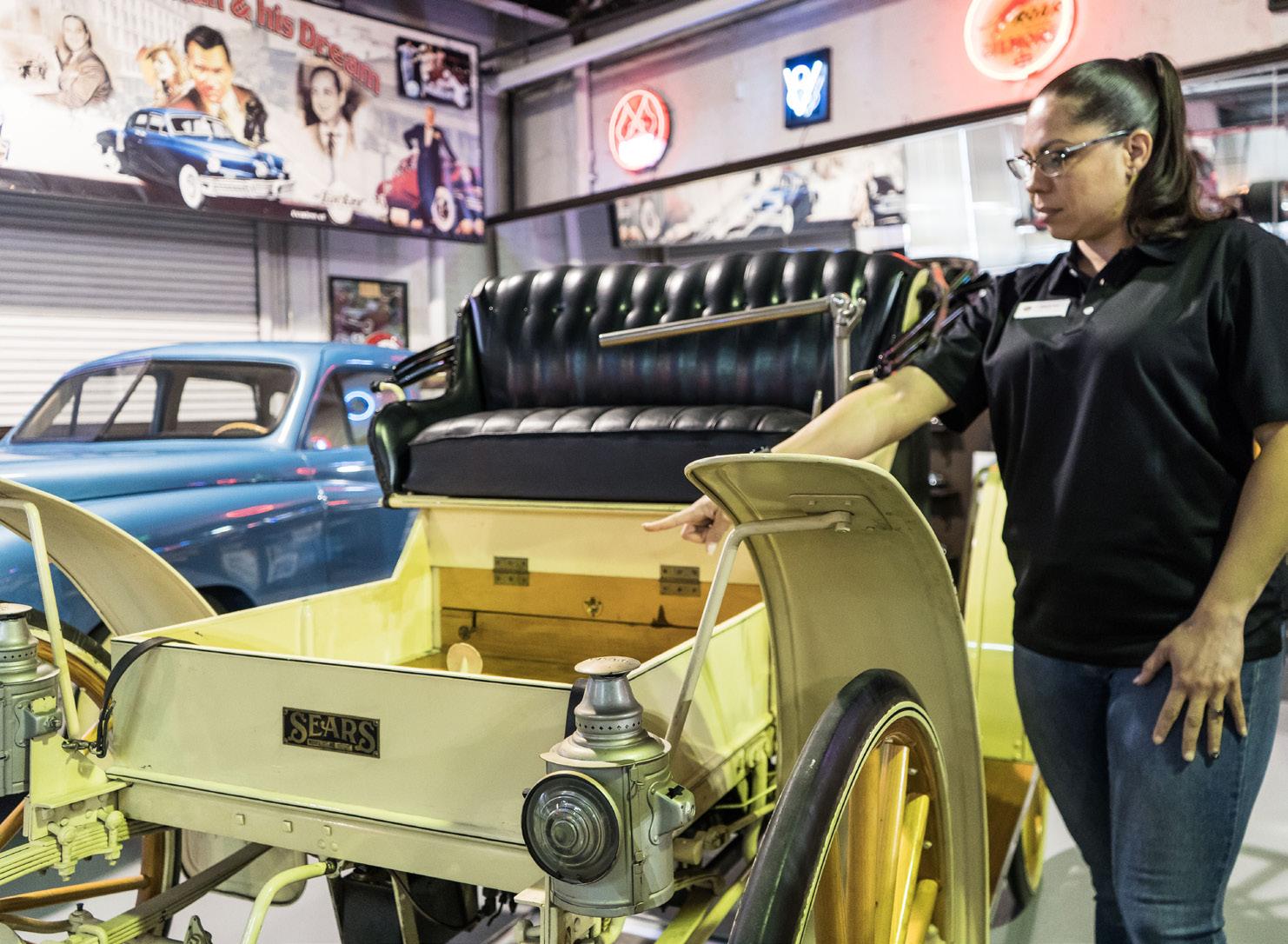
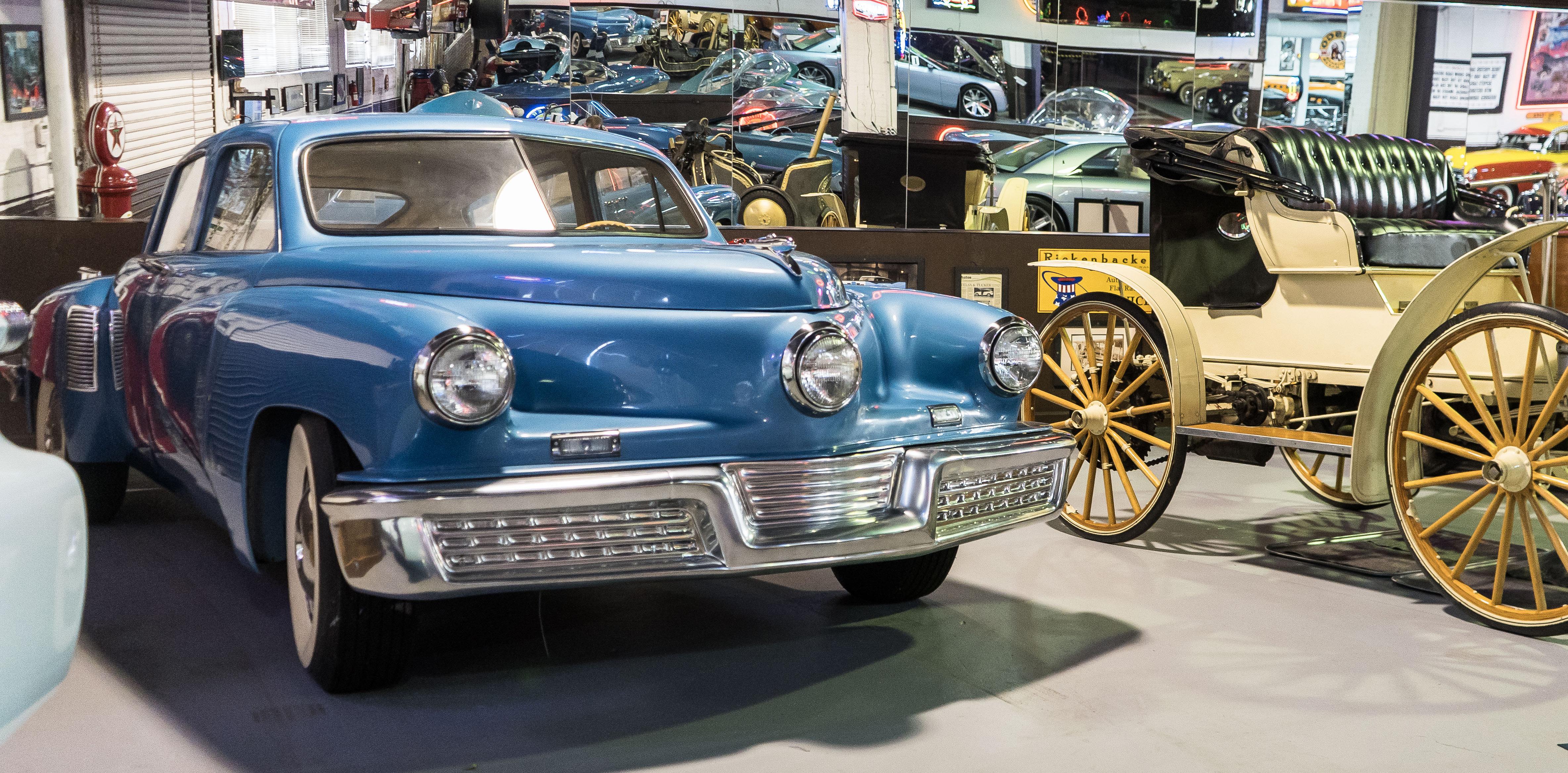
“Having the Made in Chicago area is an exclamation point on our message of being Chicago people,” Olson said. “The people who come to the museum both as car guys and friends of car guys have pre conceived notions of what to expect, and the depth and variety of our facility always blows their expectations out of the water.” Iconic cars such as 1948 Tucker “Torpedo” 48 and 1909 Sears Roebuck can be found in the collection.
Olson intends to grow his Chicago connections even further. He invited a DEPaul production design class over in the spring quarter of 2022 to create a de sign for the museum’s disused southeast wall.
“The diorama they created emanates some of the other facades of buildings we have, like Marshall Fields where Andrew sits or our Hot Doug’s homage,” Olsen
estate mogul at the helm of Imperial Re alty.
Klairmont Kollections got its start as a private storage facility for Mr. Klair mont’s collection of unique vehicles and memorabilia, located in what was for merly the vast W.F. Hall Printing facili ty. In the months before his passing, he decided to start taking steps to open up his collection to the public, and with the museum having since achieved not-forprofit status, the job of sharing Larry’s vision with the world now falls on Olson.
In June 2022, Olson took one of the first major steps towards making this vision a reality as Claymans collection spread tightly across two brightly col ored adjoined rooms.
“They had it all ready to go, and it was just a good fit,” Clayman said. “We all thought the same people interested in Klairmont would be interested in what we have to offer. It’s the best kept-secret in Chicago, not only as a collection of cars, but also in the attention to detail, and I think people will enjoy seeing an
Chicago said. “They created a pharmacy and a dry cleaning business that was a nod to Mr. Klairmont’s own from back in the day and did a beautiful set design. Now our challenge is to engage our stake holders to bring this vision to life for ed ucational purposes and proudly exhibit this area.”
While Olson’s involvement with DePaul looks largely to the future, Clayman’s own museum has unearthed strong manufacturing ties with the current DePaul College of Liberal Arts & Social Sciences on the Lincoln Park campus.., From 1906 until the1970s the four-story brick building was occu pied by the Eugene Dietzgen Company, whose logo is still visible on its exterior. In the back room of Made in Chicago, a 1930s pen-ink filling stand manufac tured in the Dietzgen factory is on dis play, according to Clayman.
“I generally try to have one item rep resent a company, but of course there are exceptions,” Clayman said. “It’s a passion project, so the budget and space


can be limited, but there’s so much I’m still just scratching the surface on. I especially want to add more from the Bronzeville neighborhood. Finding and telling the stories of female-owned and Black-owned businesses has become a focus, and is something I’m going to work on over the coming year.”
Although the length of Made in Chi cago’s partnership with Klairmont re mains to be determined, Olson stressed that he intends to keep the relationship going for as long as possible and hopes that both Klairmont Kollections and Clayman’s archives will prove to be an invaluable tool for enlightening future generations of Chicagoans.

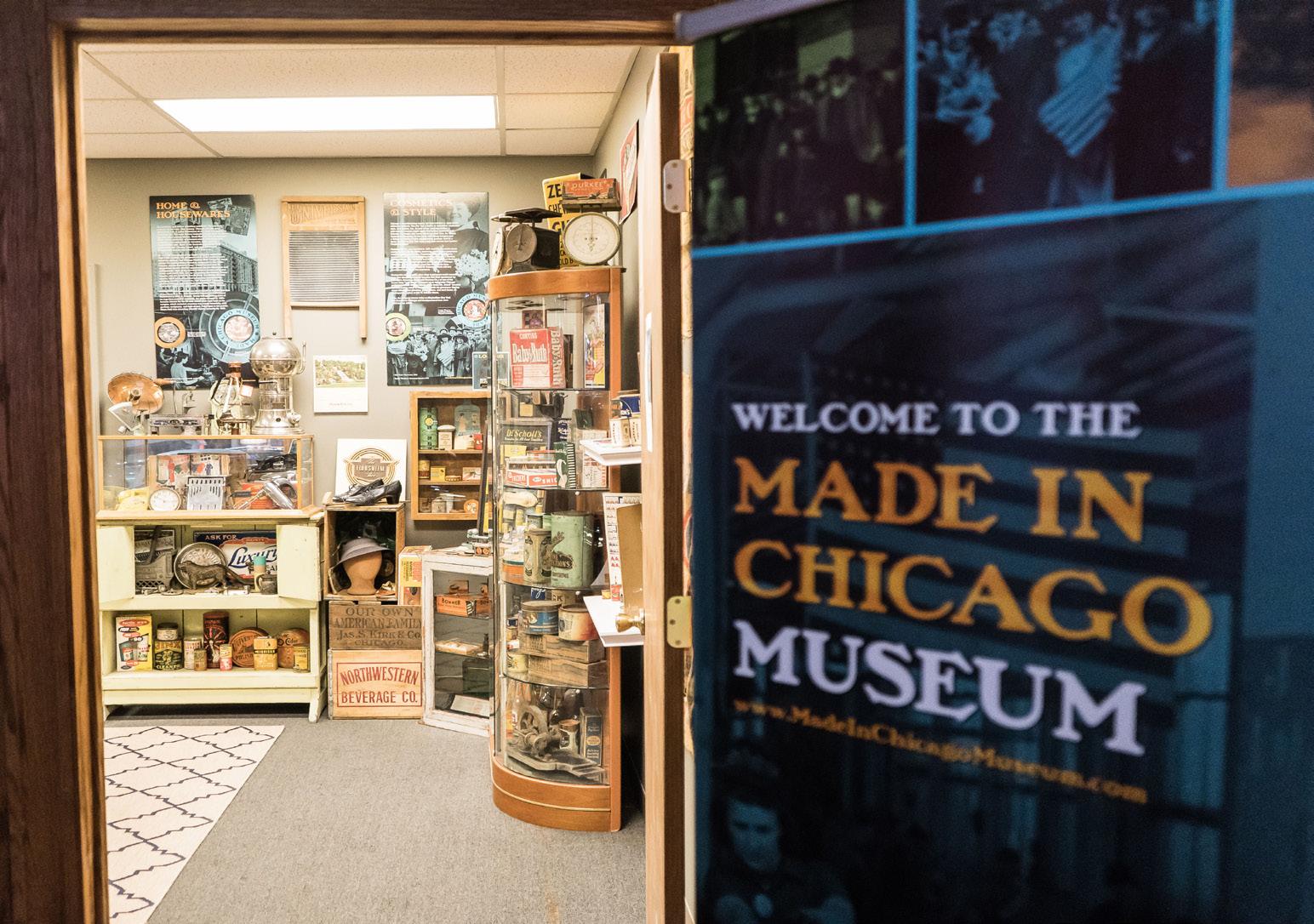

“Museums are much more than just static displays of yesteryear,” Olson said. “My expectation is that they should be hubs of education, learning, and enter tainment. All of those things are repre sented in the museum, and we’re a great reminder not only of what Chicago was, but a reminder of what it could and should be still.”
 In the spring of 2022, DePaul students in the Production Design class created the design on the southeast wall of the museum.
In the spring of 2022, DePaul students in the Production Design class created the design on the southeast wall of the museum.
La isla de Puerto Rico ha sido azotada por otra crisis, cinco años después del huracán María.

El huracán Fiona tocó tierra en Puerto Rico el 17 de septiembre acompañado de lluviastorrenciales, vientos de 85 mph (135 kmh) e inundaciones severas.
“La verdad es que es difícil”, dijo Carlos Torres, residente de San Juan, Puerto Rico, de 54 años.. “No hay agua ni electricidad. Mi novia tiene que comprar [agua] o pedirla prestada a otra persona y bañarse con agua de lluvia”.

La isla sufrió una devastación similar después del huracán María en septiembre de 2017. Se estima que María impactó la tierra como una tormenta de categoría cuatro, pero los sensores de viento de Puerto Rico resultaron dañados, lo que dejó a los meteorólogos con solo una estimación aproximada para describir los vientos terrestres que se produjeron.
María arrasó casas, carreteras, señales de tránsito, escuelas y comercios.
“La isla aún no estaba completamente recuperada de los efectos de María en términos de infraestructura”, dijo Nezih Altay, profesor de DePaul y experto en ayuda humanitaria, logística y gestión y respuesta a desastres. “Este huracán solo exacerba su dolor”.
Sin embargo, María no fue la única fuerza destructiva que afectó a Puerto Rico en los últimos cinco años.
Desde 2017, este país no solo ha experimentado desastres naturales en forma de terremotos, sino también desastres socioeconómicos en forma de protestas, agitación política y la pandemia del Covid-19. Actualmente, existen condiciones menos que ideales para la reconstrucción de la isla.
A raíz del huracán Fiona, el presidente Biden anunció que se proporcionarán $60 millones en ayuda a Puerto Rico.
“La ayuda humanitaria es ayuda de emergencia, no ayuda para el desarrollo”, dijo Altay. “La ayuda humanitaria es [solo] asistencia a corto plazo. Puerto Rico necesita reconstruir su infraestructura”.
Después del huracán María, el Congreso asignó $40 mil millones en ayuda por el desastre en Puerto Rico. Esto contrasta con el valor estimado de $90 mil millones que Puerto Rico realmente perdió en daños. Incluso, para fines de mayo de 2019, Puerto Rico recibió menos de $14 mil millones.
“Cuando se trata de ayuda para el desarrollo, los problemas son los mismos en todas partes”, dijo Altay. “La corrupción impide que el dinero [llegue] a personas y lugares necesitados. Siempre hay política involucrada”.
Isabel Olivo, una joven puertorriqueña estudiante de DePaul, dice que ve cómo las crisis humanitarias que Puerto Rico continúa experimentando están entrelazadas con la política estadounidense.
“Creo que Donald Trump, al minimizar los efectos del huracán María, puso más énfasis en la idea de que, en su mayor parte, Puerto Rico y los habitantes de la isla tienen que preocuparse por sí mismos”, dijo Olivo.
Si bien Biden ha prometido más apoyo monetario para la isla despues de María que la administración Trump, algunos dicen que todavía no es suficiente.
“En mi opinión, lo que Puerto Rico necesita, además de ayuda humanitaria… es ayuda para el desarrollo”, dijo Altay. “[Necesitan] fortalecer, reconstruir y, en algunos casos, construir desde cero la infraestructura de la isla”.
Los problemas con el agua, la electricidad y el acceso a otros elementos esenciales no ocurren solo después de un huracán. Para Puerto Rico, ha sido una lucha constante ya que la isla sufrió apagones continuos, incluso antes de que llegara el huracán Fiona.
“Es increíble”, dijo Torres. “La electricidad en mi casa simplemente va y viene”.
El dinero para las misiones de rescate, los alimentos y los refugios de emergencia brindan ayuda a corto plazo, pero Puerto Rico necesita ayuda para establecer una base mucho más sólida para no solo limitarse a la ayuda de emergencia necesaria después de
futuros desastres.
“Los $60 millones prometidos por el señor Biden no cubrirán nada más que asistencia humanitaria”, dijo Altay.
A pesar de la necesidad de desarrollo de infraestructura mayor en Puerto Rico, muchos sienten que ni siquiera están recibiendo lo mínimo cuando se trata de ayuda humanitaria.
“FEMA sí ayuda a los más pobres a arreglar sus casas”, dijo Torres. “[Pero] no me dan nada”.
Torres dijo que cree que la ayuda del gobierno siempre estuvo motivada, principalmente, por propósitos promocionales, pero incluso esa ayuda también ha disminuido con el tiempo.
“Dos cosas… obstaculizan la ayuda al desarrollo, la política y la corrupción”, dijo Altay.
También existe una disparidad entre cómo la gente conceptualiza a los Estados
Unidos como un país a diferencia de lo que realmente constituye el país.
“Siento que Puerto Rico definitivamente se pasa por alto como parte de los Estados Unidos”, dijo Olivo. “El público en general desconoce el estatus de Puerto Rico como Estado Libre Asociado, y la mayoría de la gente ni siquiera sabe lo que eso implica”.
Las personas que actualmente viven en Puerto Rico, así como las que tienen vínculos étnicos con la isla, están frustradas por la continua falta de atención y apoyo que Puerto Rico ha recibido históricamente de los Estados Unidos cuando han sufrido desastres.
Torres cree que hasta que Puerto Rico no reciba la debida atención, ayuda y desarrollo de infraestructura que necesita, la isla seguirá siendo arrasada por desastres naturales recurrentes.
“Siempre es lo mismo’’, dijo Torres.
En la cocina, Doña Inés prepara el almuerzo para la familia. Lo hace con cuidado, como le enseñó su mamá.
Ella quiere que su hijo, Ricardo, esté preparado para el partido de fútbol que tiene más tarde en una escuela cercana. Ella solo quiere que tenga éxito en cualquier rumbo que decida tomar en su vida.
De repente, escucha que algo se rompe en la sala. Ella se apresura de la manera en que solo una madre puede, solo para ver que su pequeño Ricardo acaba de romper una reliquia familiar con su pelota.
Con el rostro lleno de rabia, agarra su chancla y comienza a correr detrás de Ricardo.
Veinte años después, Ricardo es un hombre de negocios y, con gran vergüenza, les cuenta a sus padres cómo perdió todo el dinero de su inversión en una estafa evidente de NFTs.
Tanto Inés como Ricardo miran hacia un sofá cercano donde está la chancla de Inés. Luego, sus ojos se encuentran. Ricardo comienza a correr por su vida.
“Cuando mencionas la chancla, se me viene a la mente todos estos sketches [de comedia] alrededor de la madre latina con la chancla”, dijo María Camila Contreras, psicóloga clínica colombiana. “Siempre como un chiste y nunca como una preocupación sobre cómo vemos el castigo físico”.
Esta representación del castigo físico como algo común y ridículo en la cultura latina ha hecho que algunas personas lo sientan como algo normal, o incluso esperado, a la hora de criar a un niño.
Como sociedad, tendemos a estar de acuerdo con que la violencia es algo negativo, entonces, ¿por qué algunas personas la usarían contra sus propios hijos?
“[Existe] esta creencia cultural de que es lo que hay que hacer, que así se forma el carácter o que así se forma un buen ciudadano”, dijo Contreras.
El psicólogo y psicoterapeuta mexicano Rafaél Kérlegan proporcionó una explicación histórica para este comportamiento.
“Hay que entender que la cultura mexicana, como todas las culturas latinoamericanas, [...] es una cultura violenta históricamente”, dijo.
Para algunos, el castigo físico es incluso una parte esencial de una educación apropiada. La psicóloga argentina, Antonella Salerno, propone que la gente tiende a justificar esto minimizando los posibles efectos negativos o apelando a la tradición.
“La normalización como defensa es la que muchas veces aparece como: ‘Bueno, pero no es para tanto’, ‘Lo que está tratando es de criarme’ o ‘Antes era así’”, dijo. “Todos estos discursos que existen perpetúan la manera de criar a través de los castigos físicos”.
Lamentablemente, el problema del abuso de los padres en América Latina empeoró durante la pandemia y de manera desproporcionada en las comunidades de bajos ingresos, según el Banco Interamericano de Desarrollo.
Es importante reflexionar sobre cómo la normalización del castigo físico en niños de comunidades latinas podría estar afectando a la población a nivel personal y social.
Kérlegan afirma que el abuso puede causar un daño neuronal real, además del daño emocional. “El maltrato —ya propiamente hablando la violencia— siempre va a generar algún tipo de secuela” , dijo.
Además, los niños que enfrentan abuso y violencia como método común de castigo, no tendrán la misma forma de interactuar con los demás en comparación con un niño que no enfrenta ese abuso.
Contreras explicó cómo la teoría del apego aplica a los niños que sufren abuso por parte de sus padres.
Esta teoría explica la manera en que se forman las relaciones con otros en humanos desde la infancia. Dependiendo de la respuesta del cuidador a su búsqueda de afecto, la persona aprende a confiar y tener relaciones saludables, llamado apego seguro, o a desconfiar y tener dificultades para abrirse completamente, llamado apego inseguro.
“El niño busca quien lo cuide, pero quien lo cuida es quien lo lastima”, dijo Contreras. “Y eso básicamente desorganiza al niño un montón. Porque entre más lo lastime, más va a querer que lo cuide”.
Aunque hoy en día la mayoría de los padres entienden que el castigo físico tiene consecuencias negativas, eso no impide que lo utilicen en algunas ocasiones.
“Tiene que ver con la desregulación emocional de los padres y la falta de recursos alternativos para gestionar todo lo que la paternidad y la maternidad implican”, dijo Salerno. “Entonces, cuando hay desregulación emocional y la persona está sacada de sus cabales, [...] y puede llegar a este tipo de actos”.

Si bien se ha estado pintando una imagen oscura de la crianza de los hijos en la comunidad latina, sería un error centrarse sólo en los aspectos negativos cuando también hay representaciones de la crianza latina como especialmente amorosa, afectuosa y con padres involucrados en la vida de sus hijos.
“Hay más cosas culturales de las mamás latinas”, dijo Contreras. “Por ejemplo, la comida, nosotros somos muy del afecto a través de los platos, de compartir las comidas, de expresar ese cuidado con ese ‘mijito no se vaya sin desayunar’”.
Educar a los hijos y mantener una familia unida es complicado, además de causar daño a alguien a quién se ama es algo que lamentablemente sucede.
Al dar más visibilidad al cuidado que al abuso, las personas aprenderán una mejor manera de enfrentar situaciones difíciles en la crianza de los niños.
“Hay que cuestionarse por qué no le hacemos más centro y más fiesta a ese tipo de características de las mamás latinas, que están centradas en el cuidado y en el cariño, en lugar de las que están centradas en la violencia”, dijo Contreras.
 By jacqueline caRdenas Jefa de Redacción, La DePaulia
By jacqueline caRdenas Jefa de Redacción, La DePaulia
A medida que se acerca el Día de Muer tos, la ciudad de Chicago se prepara para fines de semana llenos de catrinas, cem pasúchil, ofrendas y mucha alegría.
El Día de Muertos es una tradición in dígena mexicana que implica el regreso al mundo de los vivos de los espíritus de las personas que han fallecido. La muerte no representa una ausencia, sino una presencia viva. Crear ofrendas conmemoradas con fo tos de seres queridos fallecidos y sus comi das favoritas es una oportunidad para que la muerte conviva con su familia de nuevo.
La tradición nació con los Aztecas, antes de que llegaran los colonizadores españoles y la Iglesia Católica Romana según Los An geles Times. Al morir, los Aztecas creían que era el comienzo de un viaje hacia Chicu namictlán, o La Tierra de Los Muertos, has ta llegar al lugar de descanso final, Mictlán.
El Día de Muertos adoptó cualidades mestizas después de la llegada de los es pañoles y desde entonces la gente añadió su propio toque moderno.
Si quieres participar en esta celebración, asiste a estos eventos los fines de octubre y principios de noviembre.
Creando cempasúchiles de papel
Uno de los grupos latinx de la Univer sidad DePaul, Tepeyac, se reúne el 26 de octubre de 4-5 p.m. en el Centro de Estudi antes en Lincoln Park en el salón 104 para crear cempasúchil de papel. No tienes que ser miembro de Tepeyac para participar.
El Museo Nacional de Arte Mexicano en Pilsen tendrá una exposición de Día de Muertos para recordar las personas de Méx ico y los Estados Unidos que han fallecido por Covid-19 y otras tragedias en el último año, como los que murieron en la balacera de escuela de Uvalde, Texas. La galería prin cipal está abierta hasta el 11 de diciembre en 1852 W Calle 19.
Desfile de Halloween Arts in the Dark
Aunque este desfile no está solamente enfocado en El Día de Muertos, la organi zación de arte, LUMA8, está dedicada en traer diferentes culturas a la ciudad de Chi cago. El evento tendrá títeres de espectáculo, actuaciones creativas y más. El desfile será el 29 de octubre en la calle State a las 6 p.m y es un evento gratuito, abierto al público.
Celebración del Día de los MuertosEnlace La Villita
La organización sin fines de lucro de La Villita, Enlace, celebrará El Día de Muertos
con un jardín lleno de música, comida, of rendas y hasta una casa embrujada. El even to está abierto a toda la comunidad. El even
to tomará lugar en el Sembrando Bajo el Sol Garden ubicado en 2612 S. Trumball Ave a las 3-8pm el dos de noviembre.
Audrey Dwyer knows a lot of talented people. She wanted to use her presidency of DePaul Artists Collective (DAC) to create op portunities for the talented student artists at the university.
With that goal in mind, Dwyer and the other members of DAC created the inaugu ral Wearable Art Exhibition to celebrate the DePaul art community. Dozens of students participated in and watched the exhibition on Friday.

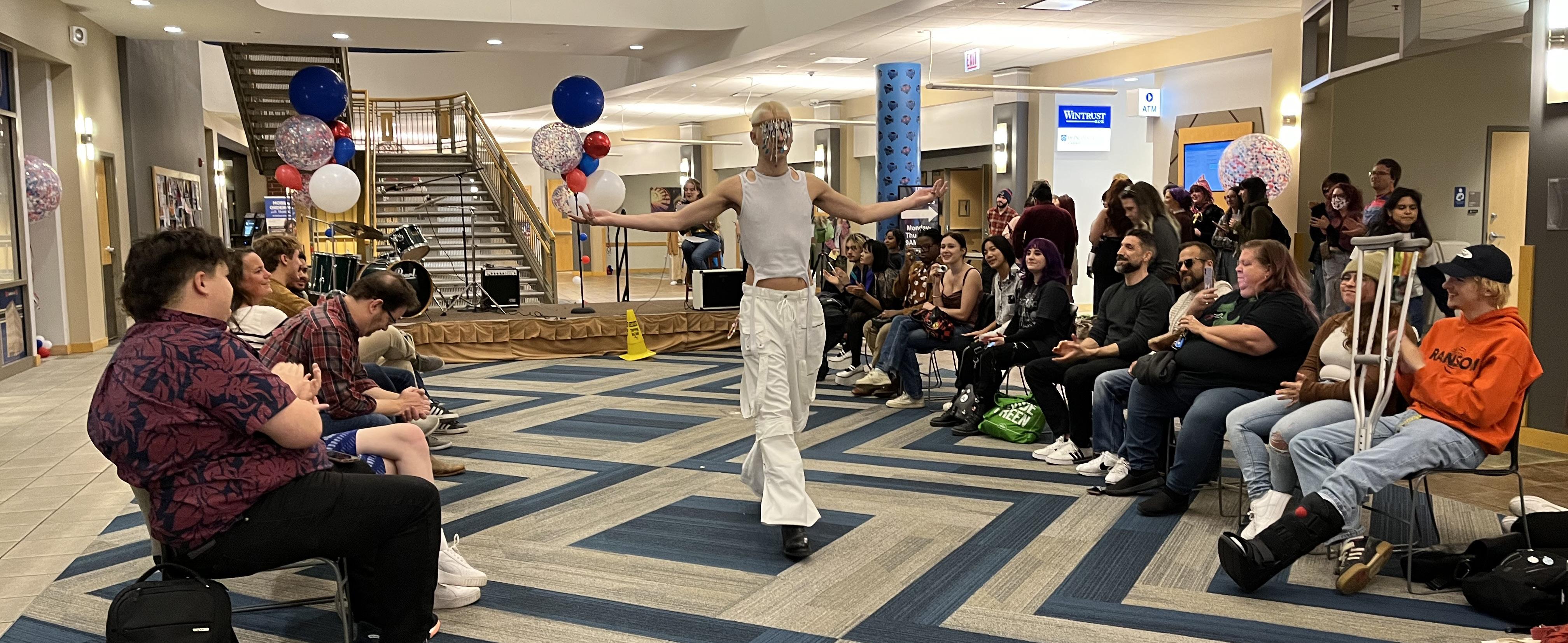
Dwyer was overcome with emotion after the event was finished. She was happy that the event came together with so many skillful art ists, designers and their supporters.
“I did this out of love, which sounds so lame but I don’t know,” Dwyer said. “I’m friends with so many talented people and I just wanted to make something for them, throw a party for them.”
Student performers, artists and models showcased wearable art including sparkly shirts, strappy pants, headgear, nature-in spired jewelry, Chucky dolls and lizard masks. Dwyer organized the exhibition in the student center with other members of DAC to uplift the art created at DePaul. It is a part of DAC’s mission to explore different genres of art and foster an artistic community at De Paul.
“I was inspired by, well, two things,” Dw yer said. “The Art School here is amazing, and I feel like it’s really the underdog of DePaul. I feel like we don’t have as many opportunities even though students are so talented and the staff is so amazing.”
Dwyer wanted to make sure the exhibi tion was open to all types of art, including performances. Students sang original songs, performed in drag, danced and presented other art in between the wearable art show cases.
“I really wanted to make an interdisci plinary community,” Dwyer said. “I feel like all of us are so separate. There’s the Theatre School and the [School of Music], and then there’s the Art School, but I want us to collab orate, and so I wanted to bring these people together.”
Sebastian Berrocal Ortega, an exchange student from Peru, modeled his wearable art at the exhibition.
Berrocal Ortega designed a larger-thanlife oblong headpiece inspired by the cages beekeepers use to separate the queen bee from the hive. He wore the wooden box over his head, a metal cage hanging over his face. The piece was a part of a larger project that he was working on back home in Peru.
“The theme was individualism, you know, the queen separating from the collec tive,” Berrocal Ortega said.
Andre Lopez used their wearable art to express how they feel as a nonbinary person. They created a bodysuit with metal orna ments that was tight and sharp to the touch.
“It’s meant to be about dysphoria and how it makes you kind of change your body, like dream things or want to hide things and sometimes adjust things,” Lopez said. “It’s just like trying to change the body, trying to find a body I feel comfortable with. I have a lot of stress and [anxiousness] because I don’t feel like I am me.”
Berrocal Ortega said he was thankful to the organizers of the event and wanted to see DePaul champion similar events in the future.
“It was a pretty cool event and I hope the university keeps supporting these kinds of events,” Berrocal Ortega said.
Lopez emphasized the importance of fos tering a community of artists at DePaul.
“It’s really cool to see how the same stu dents organized these kinds of activities for other students,” Lopez said. “I really love that. I think it’s really important, artists supporting other artists.”
Jax Fink, a senior and the treasurer of DAC, helped sell art at the exhibition’s vendor table. When artists signed up for the exhibi tion, they could also sign up to have wearable and non-wearable art sold at a booth near the runway. Fink owns their own jewelry busi ness and enjoyed selling their earrings along with other students’ art.
“I was at the vendor table and I found that really fun, watching people interact with oth er DePaul artists or get to wear other DePaul artists’ stuff,” Fink said.
Other organizations may charge artists extra fees to sell their art at events, so DAC wanted to allow students to sell at a price point they want, with no extra fees. This en sured that the artists were paid what their art is worth. After students priced their items, DAC added an additional 20% on top that
would go back to the organization.
Dwyer said DAC would use the proceeds to create a workshop for students.
“We wanted to raise money tonight so that we could do a ceramics workshop or something working with clay,” Dwyer said.
Madeline Zawada, communications chair of DAC, said that anyone who is inter ested can take part in DAC. There is no offi cial membership to the collective. People can come and go as they want, attending which ever events they are able or interested in.“The
best way to join is to just follow us and see what we’re up to,” Zawada said.
DAC posts about their events on Ins tagram, @depaulartistscollective, and on GroupMe, which students can join using the Linktree in their bio. The Wearable Art Exhi bition is also available to rewatch on DAC’s Instagram page.

In addition to a potential ceramics work shop, the collective is planning a gallery exhi bition for next year, group outings and more opportunities for vendor tables.
 Sebastian Berrocal Ortega (left) and Andre Lopez (right) pose with their conceptual wearable art pieces.
Sebastian Berrocal Ortega (left) and Andre Lopez (right) pose with their conceptual wearable art pieces.
It really shouldn’t surprise anyone that Chicago has a plethora of haunted locations.
Considering the history of this great city, there are plenty of tragedies and people that can lead to haunted connec tions such as catastrophes like the Chica go fire and the Eastland disaster.
Then, there are the city icons like Al Capone and H.H. Holmes.
There are three specific haunted lo cations that are particularly accessible to DePaul students. If you’re looking for a good spooky ambience, check out these paranormal spots.

Built in 1893 in anticipation of the World’s Fair, The Congress Hotel has lots of haunted history.
According to Time Out Chicago, it is the second-most haunted place in the city. H.H. Holmes, known as one of the first recorded serial killers, would loiter in the lobby of the Congress looking for new victims to lure back to his own hotel, also know as the “Murder Castle.”
Another frequent customer of this famous hotel was the notorious Chicago mobster, Al Capone. Most active in Chi cago between 1925 and 1931, he would often use the Congress as his unofficial headquarters for “business meetings.” Manycolleagues would enter the ho tel with Capone and his crew but never
come out.
Customers regularly complain about supernatural activity at the hotel, espe cially on the fourth floor. Check it out for yourself at 520 S. Michigan Avenue.
Built back when Lincoln Park was a mass cemetery for Chicago in the 1840s, the Couch Mausoleum is one of the only standing graves in Lincoln Park.

It is one of the last standing struc tures that survived the Chicago Fire.
The story behind the Couch Mau soleum does not have the most horrific origin.
James Couch had this mausoleum
multiple hotels across Chicago and were pretty successful.
Couch died in 1857 while on vacation in Cuba, and his remains were sent back to be put in the mausoleum.
As the Couch family passed away, more members were put in the tomb. One of the mysteries around the tomb is why it got to stay up after all the bodies from the cemetery were relocated.
In the early 1900s, a city park dis trict worker entered the tomb to do some work around it and claimed he saw noth ing in the tomb — no bodies, just an empty mausoleum.
When this information got around,
reported surrounding this vault of death.
It was said that if you go to the mau soleum right at midnight, large, white, ghostly figures would come out of the tomb and greet visitors. These urban leg ends still spread around the mausoleum to this day.
If you are a DePaul student with nothing to do at midnight, take a stroll to the Couch Mausoleum.
Located in the Uptown neighbor hood, this iconic Chicago cemetery holds plenty of history.

Graceland Cemetery was built in 1860 just blocks away from Wrigleyville. At the time, that area of Chicago barely had any residents and felt more like a na ture preserve.
There are multiple tombs there with spooky stories surrounding them.
One of the more mysterious tombs is the one built for Inez Clarke.
She was born in 1873 and died in 1880. Her cause of death was never con firmed, but the two most frequent an swers and reports are that she was struck by lightning on a picnic or got locked out of her home during a thunderstorm.
Due to both of those revolving around thunderstorms, it is said that the statue of her on her tomb disappears when it rains.
There have also been reports of see ing a ghostly little girl wandering around the cemetery, but she can only be seen by children.
For DePaul students that spend their nights out in Wrigleyville, try traveling a few more blocks north and give Inez a visit.

 By Vanessa Lopez Asst. News Editor
By Vanessa Lopez Asst. News Editor
Chicago was greeted with 70-degree weather this weekend, giving many hope that fall still has some life. However, with temperatures dropping back into the 50s, it may be time to begin winter prepara tions.
With 39.99% of DePaul students from out of state, and 0.16% from outside the country, it is likely that many with their first taste of the Midwest. With DePaul having students from all over the globe, Chicagoans shared their winter survival tips and essentials for those preparing for their first winter in the city.
Danny Owen, 40, from Chicago's South Side, recommends anyone who is about to experience their first Chicago winter to go shopping as soon as possi ble.
“Buy a coat, a bunch of thermals, boots, gloves, beanies or anything else that will keep you warm and wrapped up,” Owen said.
According to the National Weather Service, during the winter, average daily highs in the Chicagoland area range from 30 to 38 degrees, with an annual snow fall of 37 inches. While many long-time Midwesterners may be accustomed to it, temperatures still drop to extremely low levels.
“Don't try to be the cool kid by throw ing on a sweatshirt and thinking you'll be fine,” Owen said. "It gets cold out here, so wear a coat.”
Chicagoans are used to harsh winters with heavy snowfall and freezing tem peratures, but they are also used to the city's weather being unpredictable.
“Be prepared to never be prepared for what any day in Chicago has in store for you, especially in the winter,” said Cath erine Vasquez, 37, of Bucktown.
The unpredictability of Chica go's weather is often attributed to Lake Michigan, the city's next-door neighbor. Lake Michigan extends across the entire northern region of Illinois, creating its own microclimate and causing tempera ture fluctuations throughout the city.
“I was born and raised in Chicago, and winter in Chicago is unpredictable,” Vasquez said. “Being outside in the cold can be extremely painful here, but then on other days, it will be 55 degrees and sunny, so you just never know what to expect.”
Even if you have not experienced a winter in the Midwest or have yet to buy a winter wardrobe, it does not mean you won't be able to enjoy the winter.
Jason Hopper, 45, of North Side Chi cago, believes that if you have a positive attitude toward the weather, it will be bearable and enjoyable.
“Don't be afraid to do things out side in the winter; you just need to dress according to the boss man [Chicago],” Hopper said.
Weather forecasts play an important role in people's lives. They help them de cide what to wear, when to do something and even whether or not to leave their homes.
“Get ready to be cold, but don't wor ry, you can be cold in style,” Hopper said.
W Fu
Most needed
Philz Coffee 1642 w Divison St Ch cago 60622
Most needed items: Scarfs coats gloves blanket and
55 West Monroe Main Lobby Ch cago, IL 60603
Most needed items: Gently worn coats
1607 W Howard St 3rd Floor, Ch cago, IL 60626
Most needed items: W nter coats
While Halloween may be scary, the stress of finding a unique yet sexy cos tume at a reasonable price does not have to be.
Although many Halloween enthu siasts have known their costume since Nov. 1 of last year, don't fret if you re main just as stressed at the notion of finding something to wear as you did last year. Without further ado, here are eight costumes that will not break the bank while always meeting their mark!
With "Game of Thrones" spinoff, "House of the Dragon," averaging 29 million viewers each week, it's unlike ly you'll encounter someone unfamiliar with the iconic high fantasy drama. May be I love Rhaenyra more than the average television watcher, but let's be honest, a blonde wig, plush dragons and skimpy dress never miss.
Want something easy yet unflinch ingly iconic? Look no further than chef Carmy from Hulu's latest drama "The Bear." All you need to complete this look is a dark blue apron and white T-shirt, allowing for the tasteful image of a chef who is weighed down by guilt and grief and does his best not to drown. If you're looking to take this costume to the next level, I suggest adding the best kitchen shoe of all time, the Birkenstock Boston Soft Footbed.
Too soon? Well, that's what she gets for ruling over 15 sovereign nations until her death. To separate this look from the traditional older women, I recommend sticking to monochrome colors and ac quiring a plastic tiara. Feeling too cov ered up? Add fishnets and a bra beneath your blazer, and you've got a look strong enough to cause even more scandals than Prince Andrew.
The FBI's raid on Mar-a-Lago
While this costume isn't a singular figure, I still believe it perfectly encapsu lates the state of American politics while creating the perfect opportunity for a matching look for multiple people. All you need is a dark blue or black jacket bearing the letters "FBI" in yellow and a handful of storage boxes marked 'classi fied.'
I'm not saying you can't dress up as any other train line, but you'll never be as classy and unreliable as the Brown Line. The best aspect of this look is the leeway it allows. From dressing solely in brown to making your own cardboard train car, the world is your oyster through this cos tume.

While this one may be a little out there, designing your bean costume doesn't have to be intimidating. From painting an inflatable avocado costume silver to a metallic bodysuit combined with
beaned-themed accessories, I have no doubt you'll be recognizable to everybody who encoun ters your shiny exterior.
Liz Truss and a head of lettuce
As we all know, a head of lettuce has outlasted Britain's most recent Prime Minister, Liz Truss. This costume is for you if you're looking for something trendy yet intellectual for you and your partner. For Truss, a bobbed wig and egregious-looking pantsuit will do the trick, while an all-green outfit or pullover lettuce costume will make you sim ply unmistakable.
Johnny Cash and a ring of fire
Maybe I'm biased since I love Cash, but I think this costume has the potential to be iconic while also coinciding with the most recent Tik Tok trend. With one partner dressing up in all black (bonus points if you carry a guitar) while the other dons a literal flame costume or opts for an outfit with hues of red and orange, you'll be the hottest couple on the block.

 By Lauren Coates Staff Writer
By Lauren Coates Staff Writer
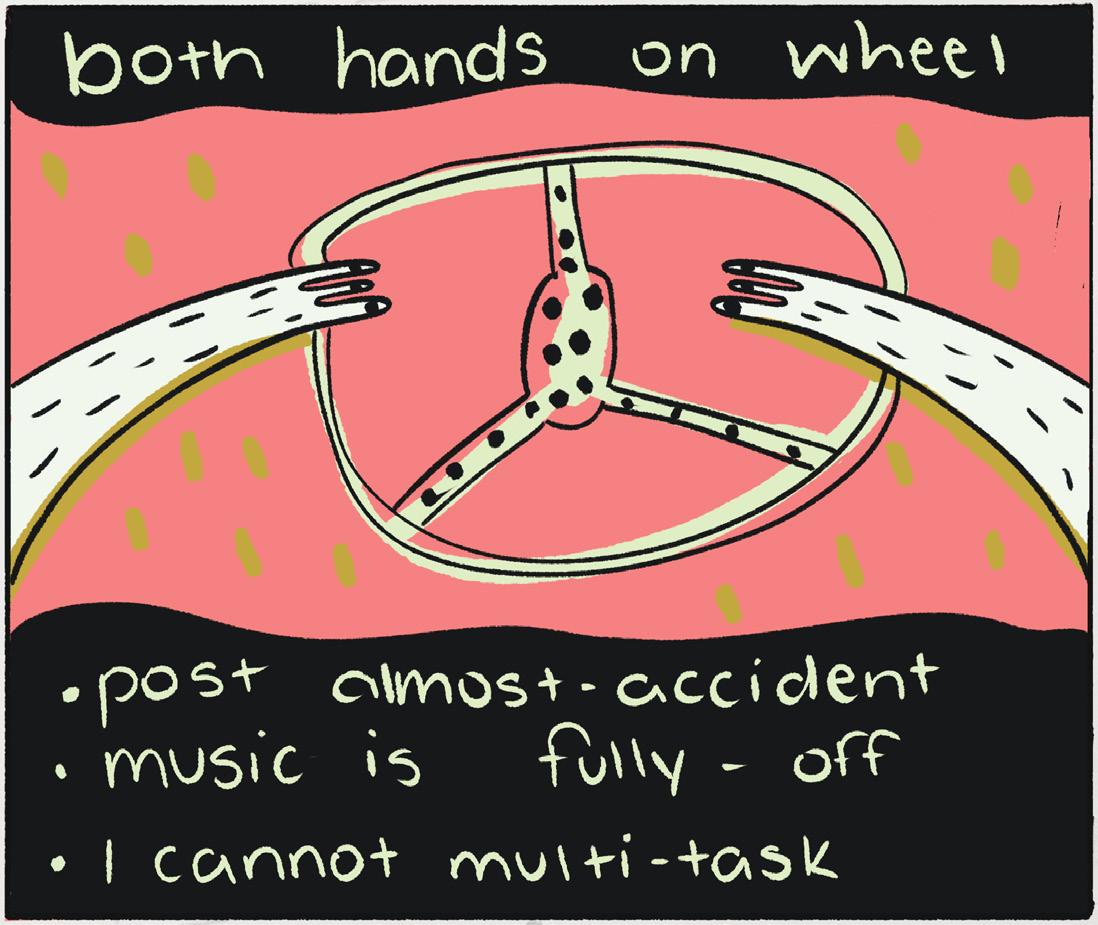

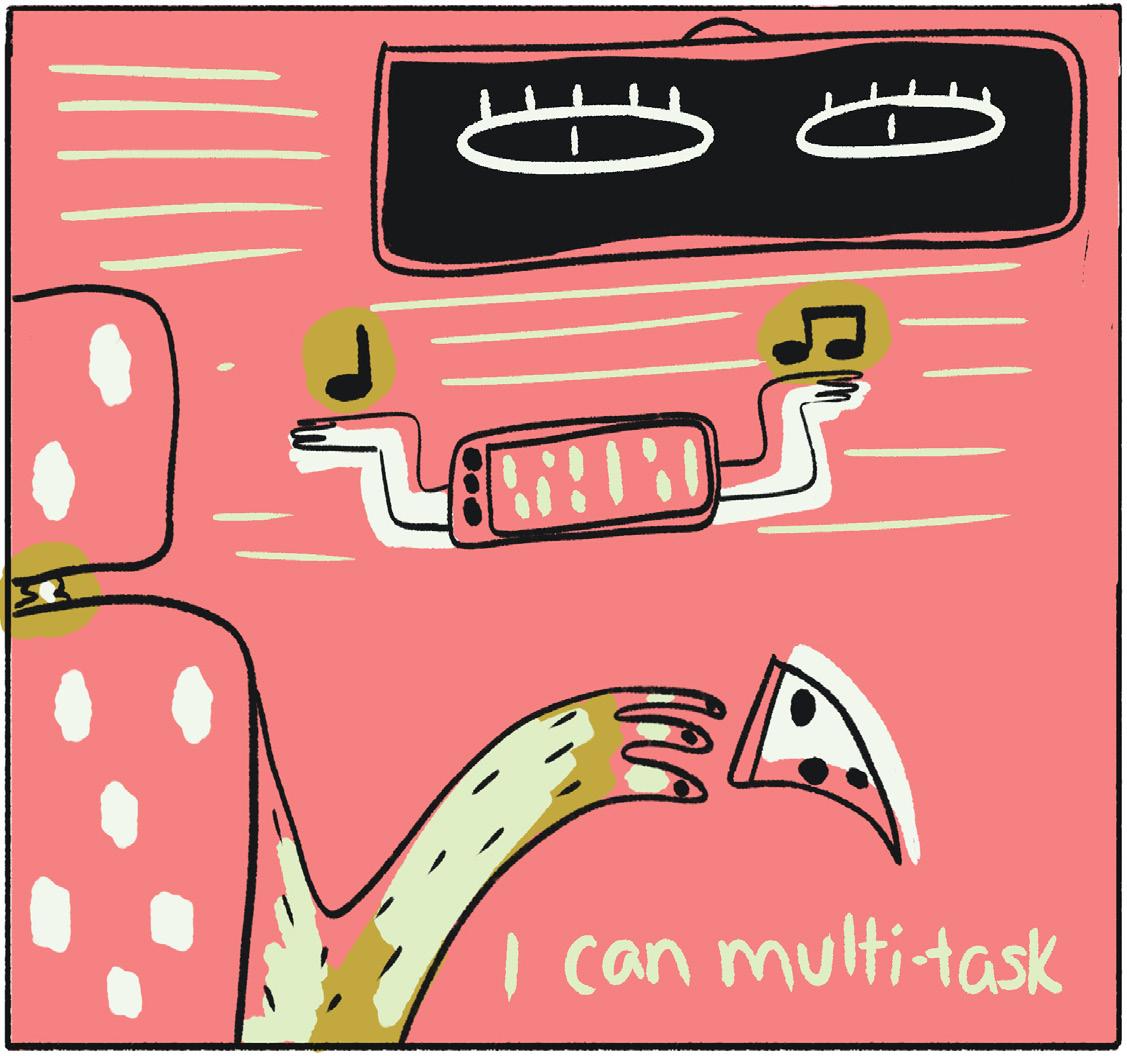
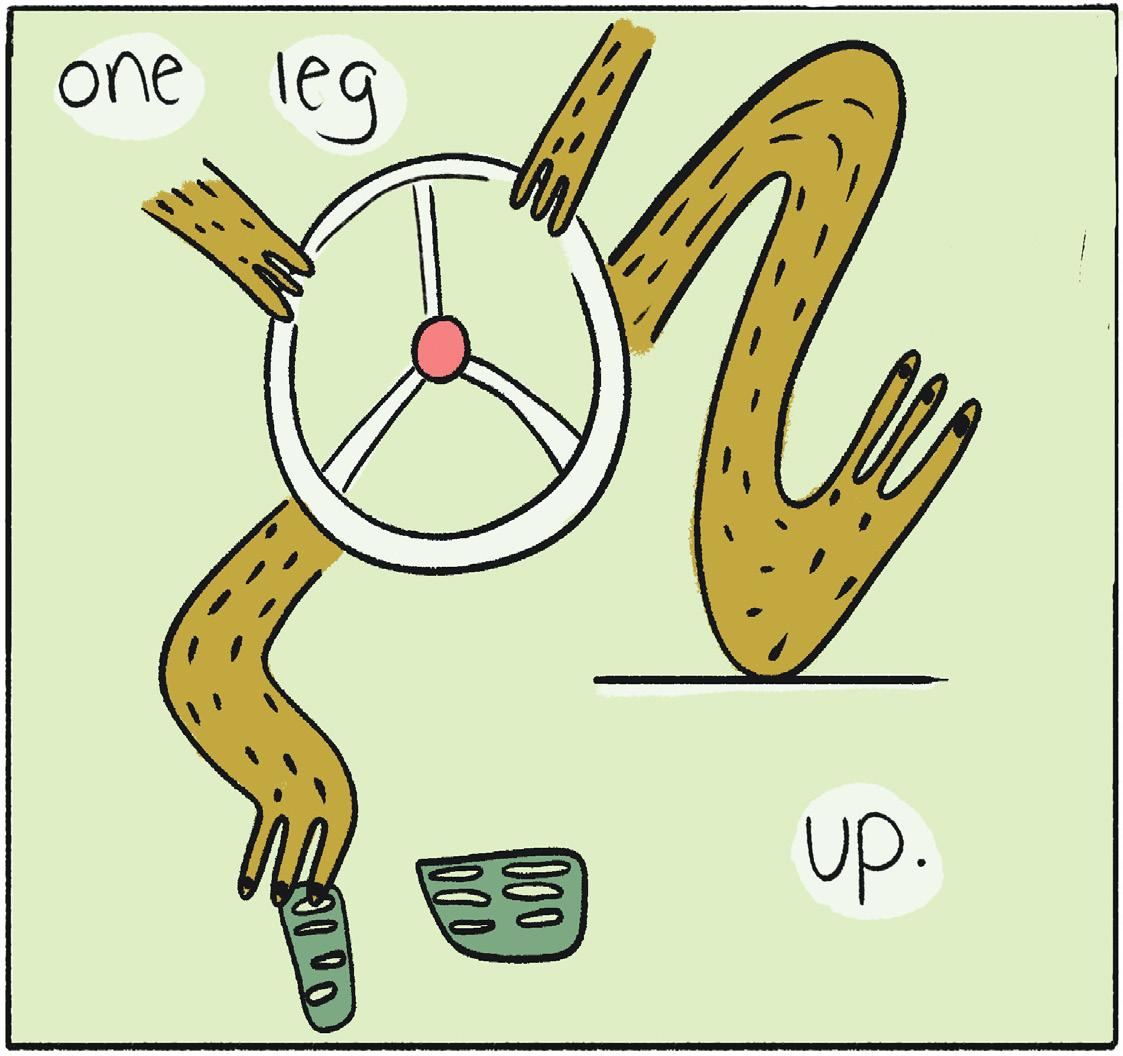

When it comes to cult classic comedies, few can boast the devoted fanbase –and the never ending quotability – of “Clue”, Jona than Lynn’s 1985 film based on the board game.
Though it may have bombed at the box office, the screwball comedy slashmur der-mystery has found a life of its own on the stage. The latest production takes a stab – pun very much intended – at inter preting “Clue” for the stage is Southport’s Mercury Theatre, who will play host to the deadly dinner party now through January 1. From clever staging to sharp direction to a pitch-perfect ensemble cast, Mercury The atre’s “Clue” is an uproariously funny mys tery-comedy that more than does justice to a beloved classic.
Starring Mark David Kaplan as Wad sworth,a role originated by Tim Curry, Clue follows a group of six bumbling strangers, all of whom are being unknowingly black mailed by the same dastardly mastermind, Mr. Boddy.
Locked in a sprawling mansion and each armed with a deadly weapon, tensions quickly mount as the hapless guests – Mr. Green, Colonel Mustard, Mrs. White, Miss Scarlet, Professor Plum and Mrs. Peacock –struggle to unmask the killer amongst them, or at the very least, make it out of the manor alive.
With an original ensemble cast that fea tured the likes of Madeline Kahn, Michael McKean and Christopher Lloyd, any staging of “Clue” faces the immediate uphill battle of attempting to replicate, pay homage to or somehow improve upon the original perfor mances that made the original film such a classic.
Though it would certainly be a fool’s er rand to attempt a direct recreation of linereads like Mrs. White’s ‘flames!’ or Wad sworth’s finale monologue, both the cast and the audience move through the story ever-aware of the influence of the original.
Such quotable source material provides the Mercury Theatre the difficult task of re imagining Clue in their own unique flare.
It is happily, then, that I can report the ensemble cast put together by Christopher Chase Carter is more than up to the task.
Working in beautiful comedic harmony, each of the seven leads, and the scene-steal ing french maid Yvette, fundamentally un derstands the conceit behind their charac ters.
Through this confidence and under standing, it’s a joy to watch each player find ing time to shine in their own right while also contributing to the controlled chaos of the large ensemble scenes.
Leading the charge is, of course, the not-so-humble butler Wadsworth, played to perfection by Caplan, who gives a perfor mance so full of firecracker physical comedy
he can sometimes be dizzying to watch.
The simultaneous restraint and vivacity with which Caplan brings Wadsworth to life is the anchor of the entire show, developing perfectly as the narrative unfolds and his sanity begins to slowly slip away.
Though his performance is so consis tently terrific, it is hard to pick a standout moment. The aforementioned finale mono logue, complete with racing around the stage in faux-reverse, is so staggeringly ener getic it is impossible to forget. One wonders who Caplan will manage to replicate such a performance five nights a week for the next two and a half months.
The rest of the ensemble is equally stel lar. Though some may take ever so slightly longer than others to find their footing, once the play ticks past the 20-minute mark, ev eryone is clearly more than willing to play
ball with each other. Such eager comedic collaboration results in a number of mem orable moments missing entirely from the film. One particularly striking sequence fea tures the paired-off dinner guests perform ing pseudo-dance numbers as they patrol the house for clues.
It is a bold directorial choice and a tes tament to the willingness of director Walter Stearns to forge a comedic identity beyond the original film.
Similarly memorable in contrast to the 1985 flick is Tiffany T. Taylor as Yvette – the ditsy french maid who serves as little more than eye candy in the film.
Though Yvette certainly maintains her sex appeal, Taylor brings a knowing wit and tongue-in-cheek flare to the character which makes her feel like a fully-fledged member of the dinner party, not just a one-off joke.
In addition to constantly looking for ways to build upon the comedy of the orig inal film, Mercury Theatre’s “Clue” makes clever use of staging and set design to craft a Boddy Manor that clearly resembles the film while staying singularly suited to this partic ular production. The physical theater itself is home to a modest stage that initially prompts questions of how Stearns will manage the labyrinthian complexity of the film’s set. It becomes immediately clea, though, that thanks to Jonathan Berg-Einhorn’s inge nuity, the Mercury is more than capable of playing home to a mansion with never end ing corridors and secret passages. Just how Einhorn’s set functions is a revelation in and of itself that I’ll not spoil here, but rest as sured - when it comes to the physical con straints of the stage, “Clue” has nothing to worry about.
Virtually every aspect of Mercury The atre’s brilliant production of “Clue” feels si multaneously reverent of the original film while developing a fresh comedic identity.
The result is a riotous evening at the theater that will leave even the most dis cerning and die-hard of Clue fans more than satisfied.
My favorite way to make my skin crawl is with a good horror movie. With so many horror movies out there, it can be hard to pick which one to watch during this festive season. To help you out, I’ve compiled a list of some of my favorite movies that make me sleep with the lights on.

“Halloween” (1978)
“Halloween” (1978) is as good of a place to start as any. This movie created many of the tropes that have become synonymous with the horror genre since the release. Jamie Lee Curtis stars as a high schooler who is hunt ed for unknown reasons by the now iconic serial killer Micheal Myers. The story is very simple, so if you’re watching with friends who like to riff on the movies, you should not have any problems following along. Director John Carpenter, also composed the hypnotic theme which plays in my head on loop.
A more recent addition to my list is Ari
Aster’s “Hereditary.” Out of all my suggestions, this one probably freaks me out the most, despite having seen it about five times. This movie follows a family dealing with the loss of their grandmother and they start to expe rience supernatural events. Toni Collette gives a performance for the ages as a mother who digs just a little too deep into her family histo ry. This movie is all kinds of freaky and makes for a great watch if you can stomach it.
“Funny Games” (1997)
My next pick is something very different from the rest of the movies on this list. “Fun ny Games” is an Austrian horror movie from 1997 directed by Michael Haneke which fol lows a family vacation that takes a turn for the worst. Soon after they arrive, two strange men come knocking and force the family into play ing sadistic versions of European children’s
games. While it might sound like a standard home invasion movie, trust me when I say this is anything but. Without giving it away, this movie functions as a subversion of the horror genre while also being one of the most disturb ing things I have ever seen.
“The Evil Dead” (1981)
“The Evil Dead” (1981) is a crowd pleaser. Director Sam Raimi created a horror movie that is equal parts scary and goofy. Raimi later became known for his campy style and “The Evil Dead” is an excellent example of his jug gling act between laughs and scares. The mov ie follows some friends staying the night at a cabin in the woods where horrors are set loose, and it becomes a fight to survive the night.
“The Evil Dead” is most definitely a product of its time. The effects are over the top and ridicu lous; however that is part of the charm. This is
not a movie that wants to be taken dead seri ous, which the dated and gratuitous gore help exemplify. This is a very fun movie that will have you screaming one minute and laughing at the sheer ridiculousness the next.
“The Shining” (1980)
My final suggestion for something to screen this spooky season is Stanley Kubrick’s “The Shining.” This is a movie I saw at my lo cal movie theater when I was 14 and it scared me so bad that I avoided it until recently. The story centers around a man who takes a job as a caretaker of a hotel during the off season. Sinister forces and cabin fever take hold of Jack and he begins to terrorize his family. This movie achieves what modern horror wants to be. There are few jumpscares, instead using atmosphere and tension to build the scare and suspense. Nicholson gives a wonderfully wicked performance and Duvall is convinc ingly terrified. This will be one I probably skip on Halloween night, but maybe you are braver than that.
I hope everyone has a great Halloween and watches some scary movies!
In 1978, John Carpenter released into the world one of the most petrifying fic tional horror film characters to ever sur face.
Since then, Michael Myers and the Halloween franchise have come to see 13 films and various other adaptations of the character through novels and video games.
David Gordon Green’s “Halloween Ends'' is the latest addition to the exten sive line of adaptations to the franchise.
In its 44year existence, it may be the worst representation of the film and John Carpenter’s vision from 1978.
The film follows a false protagonist in the series, Corey Cunningham, played by Rohan Campbell.
Cunningham’s story begins as he babysits an energetic and obnoxious child on Halloween night.
In horror film fashion, the kid sus pensefully hides from Cunningham and locks him in a room.
Cunningham panics and kicks the door open, thereby knocking the child over a railing to his demise.
Concluding this scene, Cunningham is acknowledged as the babysitter who murdered a child and was given the cold shoulder by everyone in the fictional town of Haddonfield, IL.
While the addition of this new char acter was refreshing and seemed to be heading somewhere, it ultimately led to nothing but the limitation of screen time for Michael Myers.

As the film unfolded, it became more evident that Cunningham’s timeline had no purpose.
After 44 years of service in the en tertainment industry and countless near heart attack moments, Myers’s career on the big screen is ending most timidly.
The film lacked several classic My ers cliches such as his gruesome murders and suspenseful pursuit of his victims.
The scariest part of my entire theater experience was when I was told at the concessions that they do not accept cash or Apple Pay.
On a positive note, from a film per spective, the build-up of the Cunning ham character was excellent if you were not to consider that it is a movie exclu sively based on the horrid acts of Myers.
The raw emotion brought to the screen by Campbell while portraying his character for Cunningham was phenom enal.
His ability to transition an introvert ed college student into a daunting mon ster without a hiccup was impressive. It was one of the few aspects of this film that was pleasing to follow.
After watching the movie and expe riencing the deaths of Myers and Cun ningham, one notable question popped into my mind: what the hell was the point?
Before this film, Cunningham had no relation to any Halloween adaptations. Being included in this film to die, leaving no emotional purpose, was the biggest let down for the viewer.
Cunningham’s interactions with My
ers throughout the film created an un believable storyline that did not add up when looking back at the other films.
After getting bullied by the most un realistic bullies you will ever see in any movie, Corey was able to battle Myers underground in Myers’ hideout without help.
I understand the concept of Michael Myers being on his last leg as he is slowly deteriorating.
Still, to allow Myers to get dominated in such a manner, it was as if the writers were flipping off the viewers and forcing us to understand the decision here.
Understanding that the crew had been announced to be struggling with the filming process with delays and a high number of reshoots, this film never
felt as if the crew intended it to be this way.
The film's approach makes me won der as a viewer how indecisive this crew was. Looking back at the original trailer for this film, we can see numerous scenes included in the trailer that never surface on screen, many of which incorporate Myers.
The film had the potential to be a great Halloween movie, but they decided not to allow it to be that.
The expectation of experiencing one last Myers slow-paced chase scene or high-suspense jump scare never came to be, which was the film's most disappoint ing element.

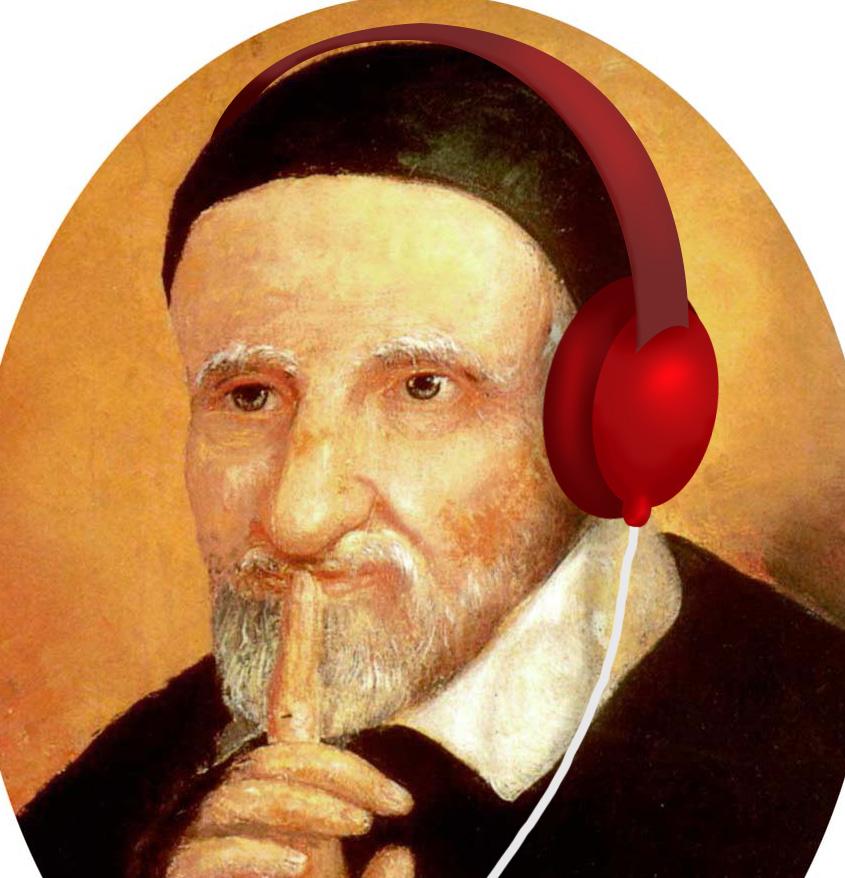 By LiLLy K eLLer Arts & Life Editor
By LiLLy K eLLer Arts & Life Editor
As October creeps to an end and the sun begins to set earlier, there is only one thing on many people's minds: Hallow een. Whether you're already in the spirit or merely fighting to make it through the week, it's clear that the excuse to dress up and eat an ungodly amount of bite-sized candy is the light at the end of the tunnel.
Until then, I invite you to forget your fears of failing exams and essays and em brace the horror of the season with these spine-chillingly good tunes.
Fans of FX's "What We Do in the Shad ows" will quickly recognize this song as one of the most iconic theme songs of the 21st century, or at least that's what my mom and I think. I've been obsessed with this song since the first time I heard it, and I feel it perfectly encapsulates the ominous vibes the
end of October always seems to bring. Also, I'm convinced Norma Tanega was one of the coolest people to exist.

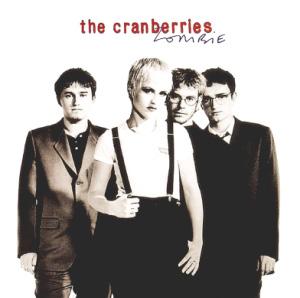
I believe The Cranberries have a song for every mood on the planet, making "Zombie" a no-brainer for this playlist. Dolores O'Ri ordan's ability to blend ferocity with sweet ness made her a staple throughout my child hood, so shoutout to my parents for having excellent music taste. I'm not sure if another band will ever be able to replicate the sound of The Cranberries and honestly, I'm alright with that because their music should never be forgotten.
The Devil went Down to Georgia – The Charlie Daniels Band

For the longest time, I was sure I had imagined this song as some sort of inside joke and that it didn't actually exist. Fortu nately, this masterpiece found its way back to me, and I now know the lyrics by heart. This track's narrative component will never not be iconic, officially making me a firm
believer that the Devil actually went down to Georgia.

As a longtime Del Rey fan, I couldn't make a playlist without this spooky banger. I love the wistful yet haunting quality of her voice on this track. It makes me feel like I am 12 and watching "American Horror Sto ry: Coven" for the first time. Speaking of occult practices, didn't Del Rey claim to use witchcraft against Trump? Anyways, believe women.
Walking with a Ghost – Tegan and Sara
While this song may sound simple, from the repetitive lyrics to recurrent chords, "Walking with a Ghost" perfectly encapsu lates moving on through the supernatural. Maybe I am drawn to anything ghosted-re lated, but this song has been one of my fa vorites for a while. Now that I think about it, I'm pretty sure I found this song through an Instagram edit and honestly, I would expect nothing less of myself.

has made it difficult for the university to spread funding to all sports with men’s ath letics often prioritized when it comes time to pay dues.
Peevy hopes that this initiative can start a new precedent of intentionally investing resources into women’s athletics at the col legiate level instead of just handing them the leftovers.
“I don’t want it to sound like charity be cause it isn’t,” Peevy said. “In my 22 years working in football and men’s basketball, we would proudly go out there with ini tiatives and make those programs better, and sometimes women’s athletics get left
are supported by the DePaul community.”
In order to increase engagement with the team and bring in more fans, the ath letic department has created a new internal position solely focused on marketing for women’s basketball.
“We have an unbelievable history in women’s athletics from a performance standpoint and we need to match that with the support they deserve,” Peevy said. “This initiative provides us with an opportunity to intentionally invest our time and effort into developing our women’s athletic pro grams.”
A project like this one is enough to in spire any former female athlete, especially those in the DePaul community.
behind, even though they are just as much a part of the overall athletics initiatives.”
There is still work to be done outside of the financial arena to further advance the support that women in sports receive at all levels. The women’s athletic programs at DePaul have a long and celebrated history of success, but fans would not necessarily know it from attending a game.
“If I’m looking at anything that was really disappointing from last year it was the student turnout for women’s basket ball,” Peevy said. “I think there is a lot of room for growth there, because if we can’t care about it enough on campus, how do we compete with issues outside of campus? Our female athletes need to know that they
“I’m actually a former student-athlete myself, so seeing and being part of a team that implements this here at DePaul really excites me,” Brown said. “We are doing a lot to give our women’s sports here at DePaul what they deserve.”
Arianna Raimonde, a former stu dent-athlete and junior at DePaul, is hope ful that this initiative may mark a turning point for the appreciation of women’s ath letics at the collegiate level and beyond.
“DePaul’s women’s basketball team has been so dominant in recent years that they deserve more credit and recognition for their hard work,” Rainmonde said. “It gives me hope that this is just the start and hope fully we can implement these initiatives at higher levels like the WNBA.”
The anniversary of Title IX has provid ed a platform for DePaul to highlight the accomplishments of women’s athletics and plan for their future by creating initiatives like this one.
“We’ve been continuously sharing achievements on our social media plat forms and we have a Title IX game for ev ery woman’s sport this year,” Brown said. “I am really excited and proud of everything that we have put out so far and I’m really
looking forward to what we’re working on right now.”
The ticket fee is the first step in what could potentially be many toward in creased support of and investment into women’s athletics at DePaul and elsewhere.

“It isn’t easy to be the first person to ever do something, but this is important,” Brown said about the trailblazing initiative. “But just because no one has ever done it before doesn’t mean it shouldn’t be done.”
DePaul men’s basketball is less than three weeks away from their home open er against Loyola (MD). This week, the Blue Demons received some unfortunate news regarding projected junior guard Caleb Murphy.
Head coach Tony Stubblefield an nounced Wednesday morning that Mur phy underwent a surgical procedure Tuesday on his wrist and will be reeval uated in six weeks.
Murphy will work to return to play under the guidance of the team medical staff, but an exact timetable is yet to be determined.
The junior guard was brought in to help the team fill the void left by De Paul star Javon Freeman-Liberty, who graduated after last season. In his senior season, Freeman-Liberty averaged 21.7 points and 7.3 rebounds for the Blue De mons. The hope is to make these num bers up by committee, but the injury to Murphy will likely change early plans for Stubblefield and staff.
“Caleb has been working very hard and been an asset to our team since he arrived this summer,” Stubblefield said in a statement on Wednesday. “We are obviously disappointed for him with this bump in the road. We look forward to a speedy recovery and Caleb to make his Blue Demon debut.”
Murphy, who transferred from the
University of South Florida last June, has three years of eligibility remaining at De Paul. He started 31 games last season for South Florida, averaging 11.4 points, 3.4 assists and 3.2 rebounds per game, while shooting 41.1% from the field.
“Obviously, losing a guy like Caleb [Murphy] does hurt,” said Stubblefield. “He had a great summer and was having a really good fall, but I think one of the big pluses on this team is the depth and getting guys like Ahmad Bynum, Zion Cruz and KT Raimey gives them more opportunities right away. I got all the confidence in the world in those guys and I’m sure they’ll step up.”

Murphy was in prime position to be one of the Blue Demons starting guards this season, but with him being sidelined, four-star recruit Zion Cruz will likely see an increase in minutes, along with red shirt freshman Ahmad Bynum and ju nior transfer KT Raimey.
Oklahoma graduate student Umo ja Gibson should be in the mix to take over as the team’s primary go-to guard come opening night, especially since he has some of the most experience on the team, entering his sixth collegiate season. He played in 35 games last season for the Sooners, averaging 13.3 points, 1.5 assist and 2.1 rebounds per game, while shoot ing 39% beyond the arc.
DePaul’s home opener will take place Nov. 7 when they host Loyola (MD) at 6:45 p.m. CST at Wintrust Area. Murphy joined the Blue Demons in June after transferring from the University of South Florida.
“We are doing a lot to give our women’s sports here at DePaul what they deserve.”
DeWayne Peevy DePaul’s Athletic Director

With only a handful of chances left to move up the table and earn a berth in this season’s Big East tournament, DePaul’s match against Marquette this week was a must-win.
On a chilly Wednesday afternoon at Wish Field, the Blue Demons started the week’s games off well with a 1-0 victory over Marquette. Coming into the match, the team and coaching staff knew how import ant it was to secure a win.
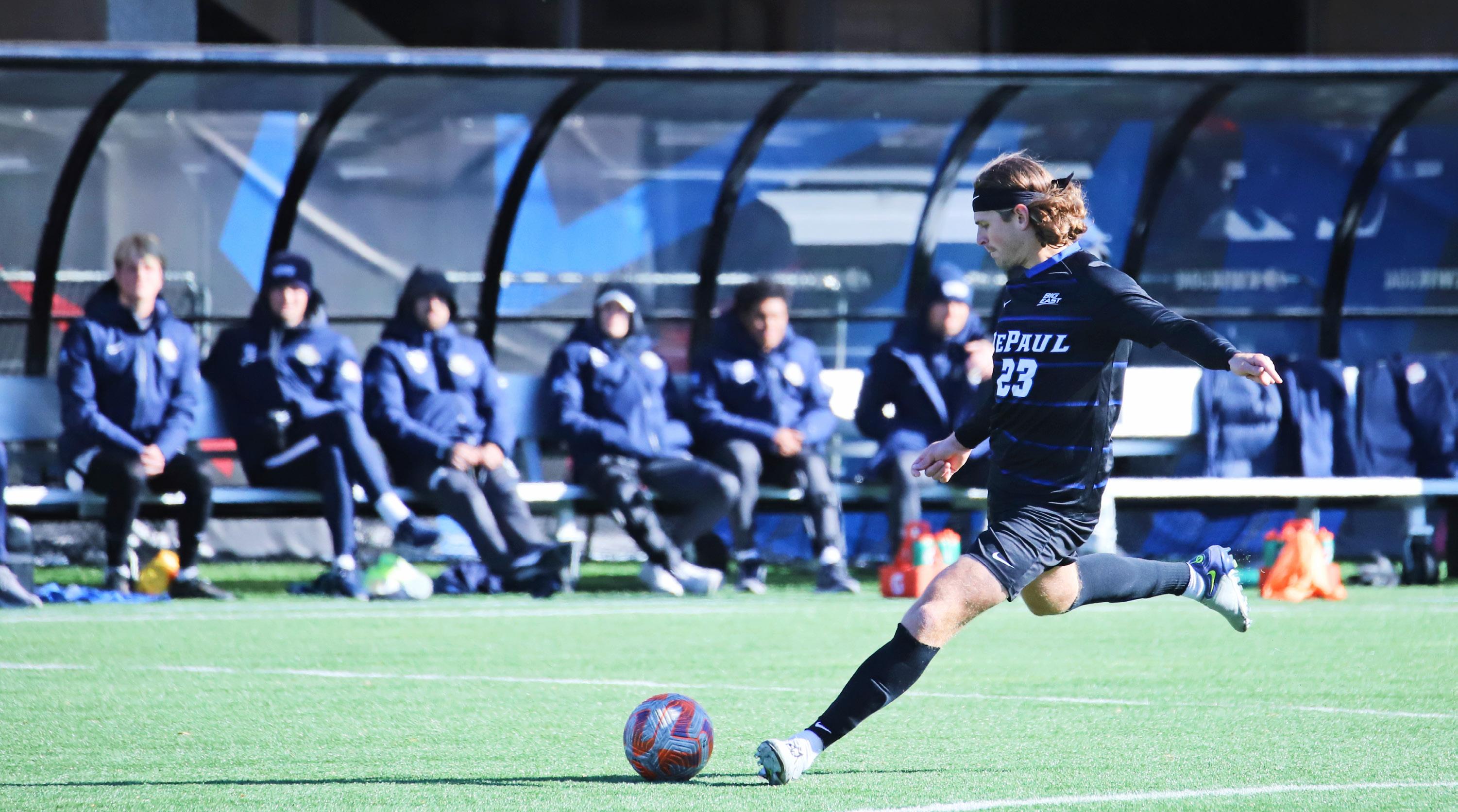
“Coming in… we said this is the biggest game of the year,” said head coach Mark Plotkin. “If we win, we stay alive. If we lose, we’re going to be looking up at [the table].”
The back line of Gripman, Herbek, Gor don and Fuderer proved they can play up to another skilled Big East attack, recording a clean sheet against the league’s top scoring team. The back four seemed to get in front of every Marquette shot and cross that came their way.
“We always have a theme of defense first, and then we go attack,” said graduate left back Jake Fuderer. “I think our backline has done a pretty good job of that all year, just staying locked in mentally every play.”
Plotkin was proud of the team’s effort to get the shutout, praising the defense’s disci plined play.
“They don’t dive in, they just block shots and block service,” Plotkin said. “We’ve real ly gotten after them to track runners in the box, and they’ve been great back there.”
On the offensive end, junior forward Marek Gonda was outstanding in hold-up play, keeping the ball away from defenders to give his teammates time to make runs forward. DePaul had the edge in possession Wednesday, and their composure in the middle third with an organized build up is the reason why.
“We knew how [Marquette] wanted to play, and we talked a lot about the spaces we could exploit once we won the ball from them,” Plotkin said, adding that the wing ers and forwards did well to release into the gaps in Marquette defense.
The turning point came when Gonda won a penalty kick in the 78th minute, after getting fouled in Marquette’s box.
Fuderer was called on to take the kick
for the Blue Demons. The graduate student left back started his run up, took a step of hesitation to deke the keeper and struck the ball with his left foot towards the bottom left corner. The keeper guessed correctly, but Fuderer’s shot had too much pace as it found the back of the net to put DePaul ahead 1-0.
DePaul stayed in control the rest of the game to secure the win and three points in the league table.
“To get three points at home is just mas sive for us and gives us momentum to go on the road this weekend,” Plotkin said.
Unfortunately for the Blue Demons, the momentum from Wednesday’s win was not enough to obtain a favorable result over the weekend.
With crescendoing Big East tournament implications, DePaul let an opportunity slip away Saturday night with a 1-0 loss at the hands of the UConn Huskies in Storrs, Conn.
Beginning at first touch, the Blue De mons seemed a step slow and out of fo cus, as UConn held an obvious advantage in possession, and won a clear majority of 50/50 balls in the middle third of the pitch.
“I think we just came out flat and were letting our initial mistakes have an effect on us,” Plotkin said. “We needed to do a better job of letting the last play go and just focus on connecting the next pass.”
An errant pass in DePaul’s defensive third from freshman center back Ethan Gordon off a goal kick broke the early tie. UConn sophomore forward Okem Chime secured possession off Gordon’s missed pass at the edge of the box on the left wing, took a couple touches and put away a scarcely con tested, low-driven shot into the right corner of the net for an easy goal in the 24th min ute.
The only early Blue Demon highlights were by sophomore keeper Ghandi Cruz, who made an incredible save on a pointblank header attempt by UConn graduate forward Frantz Pierrot.
The slow start dissatisfied Plotkin and the rest of his staff, as the Demons’ hopes of earning a top-6 spot in the table and a berth in the Big East are waning.
“It definitely is [frustrating], but you could sense the frustration on our guys too,” Plotkin said. “They knew they weren’t play ing great. We talked at halftime about con
necting the first pass and [applying] more pressure defensively to commit turnovers, and they did that.”
In the second half, DePaul looked like a completely different team.
Plotkin moved junior attacking mid fielder Jacob Huth to the number 10 spot after half time, an adjustment that seemed to unlock things for DePaul’s attack. Huth repeatedly created chances for DePaul for wards, but it proved to be too little too late, as UConn’s packed-in defense kept the De mons out of the net.
Fortunately for DePaul, the result of other Big East matches Saturday night keeps
the Blue Demons’ postseason hopes alive. DePaul is still only three points away from sixth place with two games left.
DePaul (4-5-6, 1-3-4) will travel to Omaha, Neb. Saturday for a 6:30 p.m. CDT matchup with sixth place Creighton (5-3-6, 2-2-4). The Blue Demons will have a chance to steal the Blue Jays’ spot in the table and vie for a berth in the Big East tournament.
“Our guys know their backs are up against it, but believe in themselves,” Plotkin said. “If we bring the same energy from the second half to start the game [this coming] Saturday, we’re going to make a good run at it.“
need to get better everyday we step on that floor and give maximum effort.”
There are several changes to DePaul’s roster as the team has welcomed in six new players, highlighted by four-star recruit Zion Cruz, Oklahoma transfer Umoja Gib son and South Florida transfer Caleb Mur phy.
The biggest adjustment for DePaul en tering the season will be trying to figure out how to replace Javan Freeman-Liberty. He was the Big East’s leading scorer a year ago, averaging 21.7 points per game, which ranked eighth among all NCAA Division I players.
“Javon [Freeman-Liberty] was a very good player,” Stubblefield said. “He led the Big East in scoring and I don’t think there’s just one guy that’s going to come right in and do what Javon did. I think we’re going
to have to do that from a team standpoint, being a more balanced team and having multiple guys that average 13 to 16 points per game. I don’t foresee one person being able to come in and do the heavy lifting all by themselves.”
There might not be another Free man-Liberty this upcoming season, but there is a lot of buzz surrounding guards Zion Cruz, redshirt freshman Ahmad By num and Caleb Murphy, as DePaul’s key foundational pieces moving forward.
Unfortunately, Murphy’s anticipat ed debut will have to wait. The team an nounced Wednesday, Oct. 19 that Murphy underwent a surgical procedure on his wrist and will be sidelined for at least six weeks.
“Obviously, losing a guy like Caleb [Murphy] does hurt,” Stubblefield said. “He had a great summer and was having a really good fall, but I think one of the big pluses on this team is the depth and getting
guys like Ahmad Bynum, Zion Cruz and KT Raimey gives them more opportunities right away. I got all the confidence in the world in those guys, and I’m sure they’ll step up.”
The biggest storyline from last season was DePaul’s midseason collapse. The team started off 9-1 and then lost nine of their next 10 games, resulting in them ending 15-16 on the season. Staying consistent and bouncing back when adversity hits will be a key factor for a successful 2022-23 season
“We just hit some adversity,” senior guard Jalen Terry said. “Sometimes we would just get down on ourselves when we go down 10 points and we just put our heads down. To avoid that this year, we just need to be the exact same team. I saw a bunch of teams play together for all 40 minutes as the exact same team, whether they were winning by 20 or losing by 20. They stick with it, and that’s what we need to do.”
When times get tough, this year, De Paul will have veteran leadership to lean on, especially with multiple players enter ing their fifth or sixth year at the collegiate level. Incoming graduate student transfer from Long Island university Eral Penn could be someone for younger players to look to for leadership this season.
“An advantage I have [for young play ers] is that I’ve played college basketball for a long time,” Penn said. “That does help out a lot being experienced and I understand the game and watch a lot of basketball.
The Blue Demons have an opportu nity to exceed expectations, with many people believing this might be the deepest team DePaul has had in years. Only time will tell, but it all starts on Monday, Nov. 7 when the Blue Demons host Loyola (MD) at Wintrust Arena with tip-off set for 6:45 p.m. CST.
DePaul volleyball was swept by St. John’s on Friday night in a quick match that found the Blue Demons struggling to find a way to work around a very tough Thunderbird defense.
The match was the first home match for DePaul in two weeks, and they left the gym that night with a conference record of 2-7.
Right out of the gate, St. John’s jumped to a substantial 10-3 lead, refusing to let the ball hit their side of the court and forcing DePaul to use their final timeout of the set.
St. John’s continued to impede any attacks made by DePaul, ready to block whatever was sent their way.
“Hats off to St. Johns,” head coach Marie Zidek said after the game. “They did a great job with their block, and they had us scouted well, and I think it’s a good lesson for our players to be able to take away from that match.”
St. John’s took the first set 25-14.
The second set opened with DePaul refusing to let St. John’s run away with the score again. The Blue Demons scored the first two points of the set, and St. John’s never saw more than a three-point lead.
“We can’t go on the court after a set we just lost with this negative mentality,” pin hitter Taylor Underwood said after the match. “We actually did stay together as a team, so that’s what we need to keep doing.”
St. John’s called their first timeout of the night once DePaul took a 9-8 lead. This timeout fueled a St. John’s streak, scoring point after point until they saw a 17-14 lead that had the Blue Demons calling a timeout.
“What we did against them tonight that we did better than when we played them the first time is we did a much bet ter job of getting our block involved on their attackers,” Zidek said. “Then what we saw from their attackers was that they geared up. They hit higher edges of the block that made it a little bit harder for us to defend. They responded.”
St. John’s won the second set with a slightly smaller margin at 25-19.
DePaul scored the first point of set three, but St. John’s quickly racked up the points and took the third set with a final score of 25-19, ending the match.
“We’re getting better every match, and I know we got swept and it’s really hard to see the silver linings, but I think our
block got a lot better and our team got a lot better,” Zidek said. “We just weren’t able to keep up with their responses as they made adjustments in the match, so that’s what we’ll look to do as we move forward.”
The Blue Demons started strong and never looked back during Saturday’s af ternoon matchup with Seton Hall, sweep ing the Pirates three sets to zero.
The big story of the first set was the performance of outside hitter Jill Press ly, who amassed a whopping 10 kills and maintained a 77% attack percentage in the first set alone.
“She can take over matches like that,” head coach Marie Zidek said after the game. “That is Jill at her best. Seeing the block really well and using it to score whenever she can. I thought she did a re ally nice job of that tonight.”
Fueled by Pressly’s performance, DePaul took control of the set from the beginning and defeated Seton Hall by a
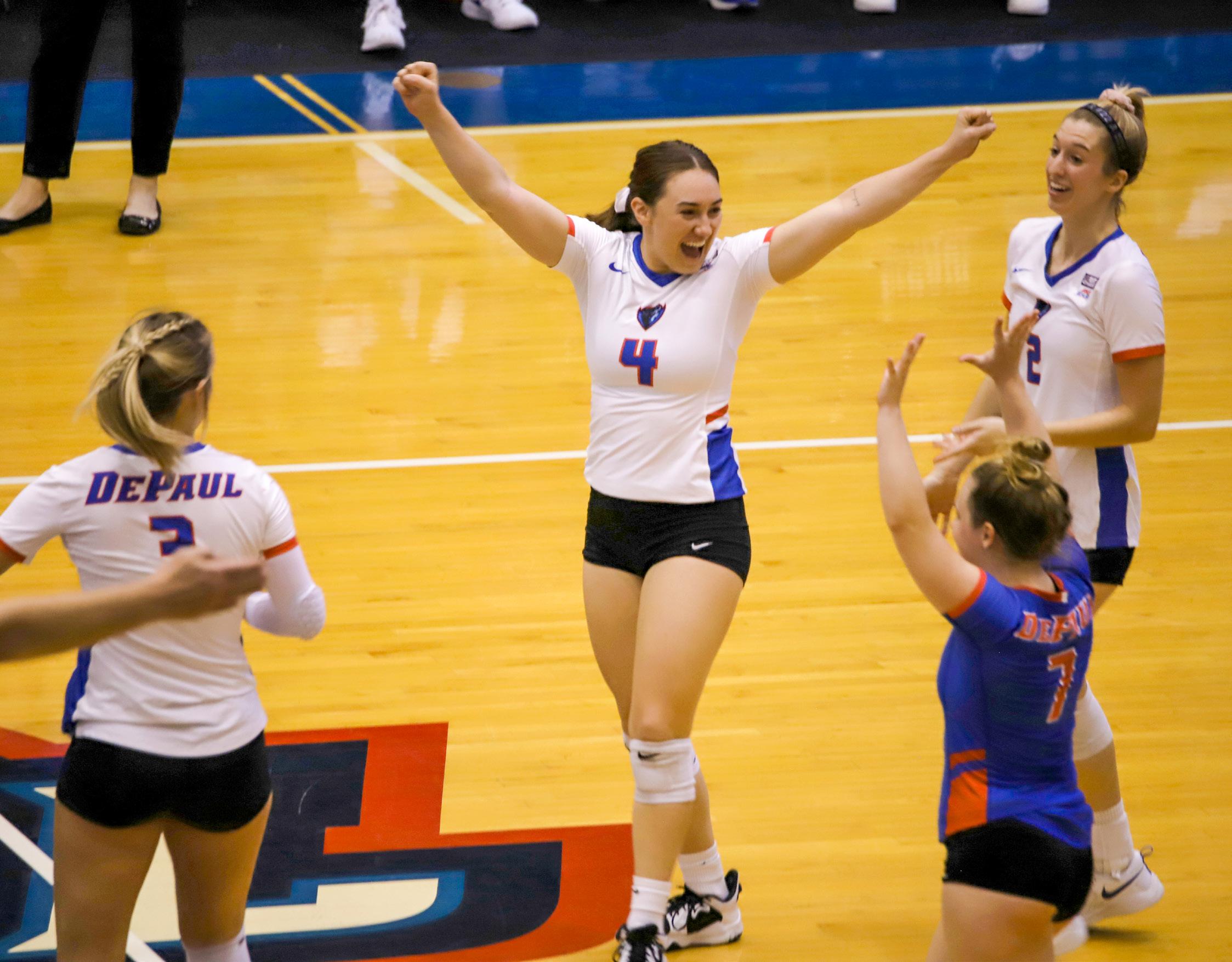
score of 25-19.
“For the most part, I just try to see where the block is headed,” Pressly said when asked about her court awareness and ability to notch a kill at will. “If I see that they’re late, I’ll try to hit the inner seam between the two or chisel their hands. I think that’s the best way to get a cheap kill and get out of the rotation.”
The second set was never in question for the Blue Demons as they went on a 9-0 scoring run midway through and won 25-17.
“I just think we did a nice job of refo cusing from last night to tonight,” Zidek said. “We know against Seton Hall you have to start fast because they can get into matches really quickly with their at tacking and defense. We came out, we re spected our opponent, and we took care of our own game on our side of the net.”
The Blue Demons never trailed in the final set and watched a Pirate matchpoint service error hand them the 25-21
victory.
“I think we did a good job of getting everyone to stay engaged and make eye contact with each other,” Jill Pressly said of DePaul’s inspired and energetic per formance. “I think coming into the mid dle, cheering everyone on, giving highfives and making eye contact really helps everyone to keep doing their job.”
Their defeat of Seton Hall puts De Paul at #8 in the Big East rankings and improves their conference record to 3-7.
The Blue Demons will face a very tough No. 2-ranked Big East opponent in Marquette at 7 p.m. on Wednesday night at McGrath-Phillips Arena.
“If we can get our block from of fense back into defense really fast, keep passing well and continue to stay kill for kill I think we have a shot with them,” Zidek said. “If not, I think it will be a fast match.”
Men’s and women’s basketball is less than two weeks away from tipoff at Win trust Arena and expectations remain high. The excitement surrounding both teams are different, but coaches, players and fans believe that DePaul basketball is on the rise.
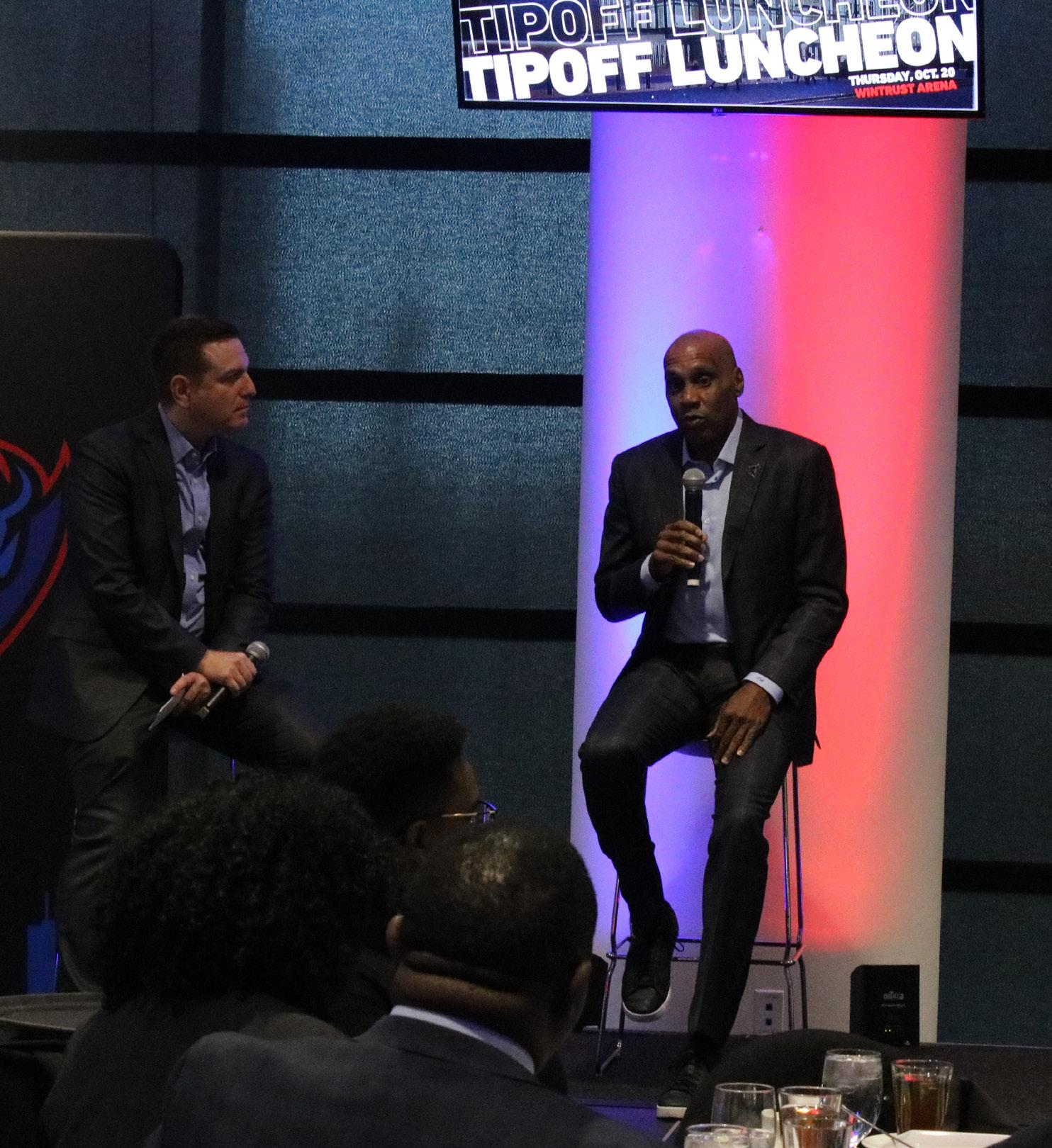
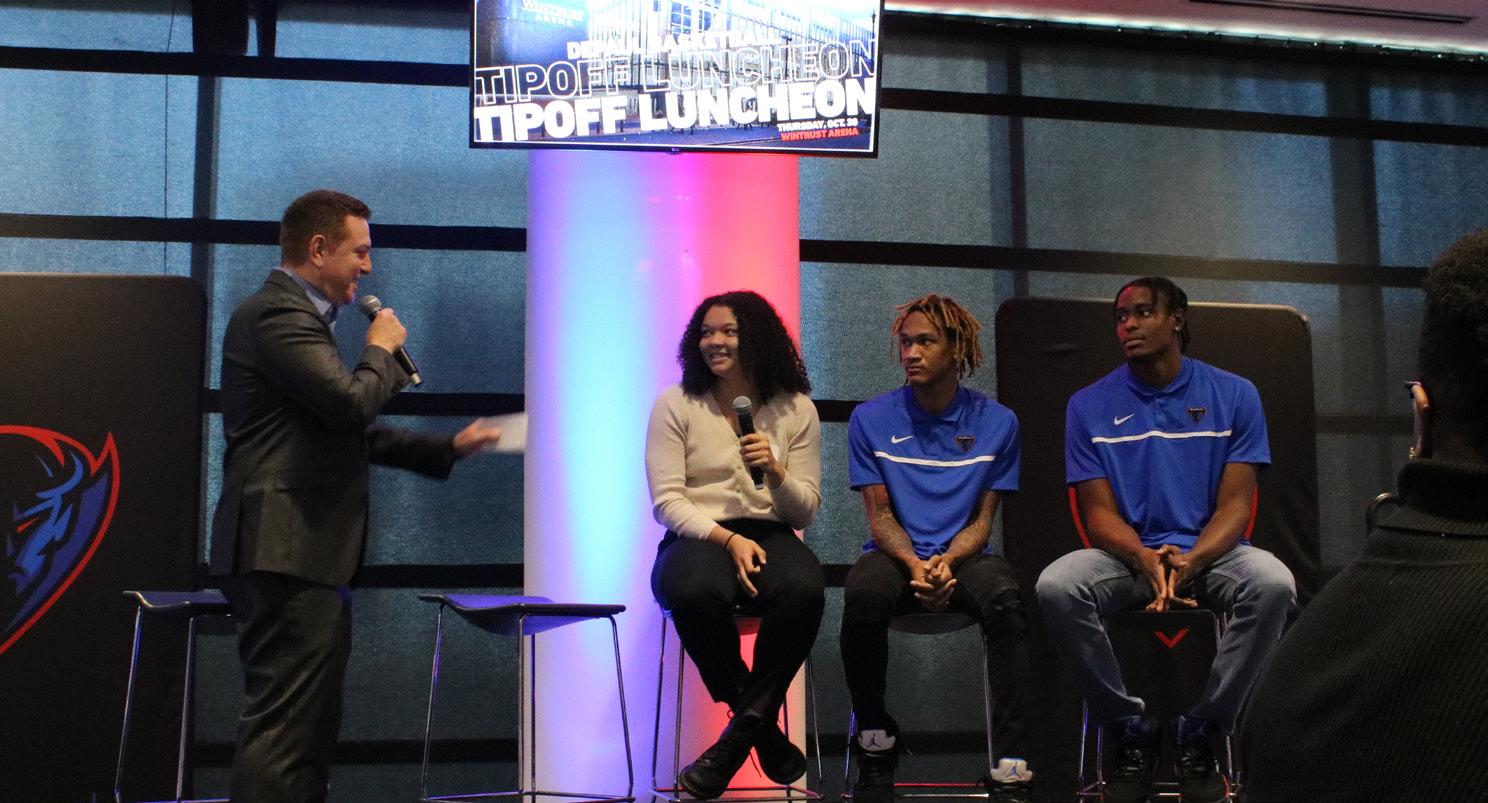

Women’s basketball head coach Doug Bruno leads a squad coming off a solid 22-11 season along with an NCAA Tour nament appearance in 2021. Head coach Tony Stubblefied and the men’s team look to take the next steps forward after finishing his inaugural season with a 1516 record, the team’s best since 2019.
“I just really want people to stick with us, come out and support this team,” Stubblefield said. “I think they’re going to like what they see and this team has great depth, lots of versatility and a team with great character that will lay it out on the line every time they step out on that court.”
Bruno is entering his 37th season as the head coach of the women’s team and his message this season is “sustained suc cess.”
“There’s three reasons, and there’s constantly three reasons,” said Bruno. “First and foremost are talent and players and great people that are players.”
The team surprised many last season by making it to the NCAA Tournament, but unfortunately, their journey ended just as quickly as it started. DePaul lost 88-57 in a lopsided first round matchup to Dayton.
The team seems more focused than ever, and they will want to build off their success from a year ago. Still, the most important concern is that everyone on the team buys in and is ready for the grind and adversity that comes with a long season.
“It’s obviously tough losing the way that they did last year, but I think it’s go ing to be about communication, stamina and buying in for the season,” graduate student guard Jade Edwards said. “It’s a long season, and you get tired halfway
through, and it’s really about just pushing through toward the end.”
Bruno and the Blue Demons recruit ed well this past offseason and the reason for optimism is partly because of the tal ent that was brought in. The newcomers have already caught the eye of a few expe rienced players.
“We have five freshmen,” Edwards said. “Unfortunately, two of them are hurt, but Madisen Wardell is a 6-foot-1 shooter, and I think if she continues to develop, she’s going to be really special. Tara Daye is ultra quick and ultra fast and ultra competitive, and I see them de veloping over the next three years putting DePaul in a good place.”
The Blue Demons know that expec tations are raised for the upcoming sea son. Being one-and-done was not good enough for Bruno and his squad who have their eyes set on a deep tournament run come March..
“I think this is a new era,” Edwards said. “[Bruno] has been talking everyday about how we’re going to bring DePaul ball back and how the last few years hasn’t been DePaul ball. I think this is like the launchpad to the new era. We have new uniforms, a new court, and I think it’s go ing to be exciting.”
The DePaul women’s basketball sea son starts Wednesday, Nov. 9 when they host American university at Wintrust Arena with tipoff set for 7 p.m. CST.
A lack of success over the last two decades has left the men’s basketball pro gram with little respect among Big East teams.
DePaul’s men’s basketball team has not finished above .500 since 2018 and have not made the NCAA March Mad ness Tournament since 2004. With little surprise, the Blue Demons are once again projected to finish last in the Big East Conference.
“You gotta take respect and go out there and earn it,” Stubblefield said. “We have to continue to work hard everyday and there can’t be any wasted days. We need to get better everyday we step on
EVA EPLEY | THE DEPAULIA A new court was designed for DePaul’s games at Wintrust Arena for the upcoming season. The men will host Loyola (MD) on Nov. 4, and women will open against American university on Nov. 9. EVA EPLEY | DEPAULIA DePaul’s radio play by play broadcaster Zach Zaidman interviews Jade Edwards, Jalen Terry and Eral Penn during Thursday’s tipoff luncheon. EVA EPLEY | THE DEPAULIA